

Adventure Rider
- Epic Rides Forum
- Day Trippin’ Forum
- eNewsletter Signup
- Become a Contributor
South America Machu Picchu, Yes, that Tourist Trap, is it Worth it?

Well, initially we just did not want to go. Way too much money and from the looks of it, everyone traveling to Peru was in the Must-go-to-Machu-Picchu zombie mode. Dear heavens, it was the first question everyone asked us while in Peru. Have you been there already or going? And we said, most probably not.
And to top it, all our dear friends that have been to Machu Picchu told us to suck it up and stop bitching as they think it is worth seeing the ruins. The reason for our initial apprehension was that many times these absolute must-sees are incredible to see, but the sheer amount of people these days flocking to them turns the experience into a mind-numbing amount of pain, fighting people to see something, and in the process getting the wallet ripped apart. The social media craze like Instagram adds to the popularity. Every influencer wants to have a shot with the blonde girl walking towards the edge with a blanket over the shoulders softly blowing in the wind. And for the love of all that is holy, that is exactly what happens there. But more about that later.
While in South Africa for a quick visit with Elsebie’s mom we had some conference calls with our two Aussie crime partners on the MP issue. Are we going or not? Some of the discussions were about our time in Peru and we had seen already so many incredible places in the country, we doubt Machu Picchu could beat it. So if we do not see it, would we miss anything?
In the end, we decided to suck it up and go. There is only two option, you walk the railroad or take the train. The girls decided to check which option would be the best. Well, the cheapest option is hitting the rails from where you park a bike at the hydro-electrical station. A 10km leisurely walk along the rail takes you in to the mountains and up to the town. Monique our Aussie friend is not a born hiker and the trek over the rails was not for her, she protested, to all our silent relieves. It was also some-ones birthday and we were in a jovial mood seeing our friends again, so the decision was made to indulge in luxury a bit and enjoy the soothing sounds of coach wheels on rails.

Train ride to Machu Picchu
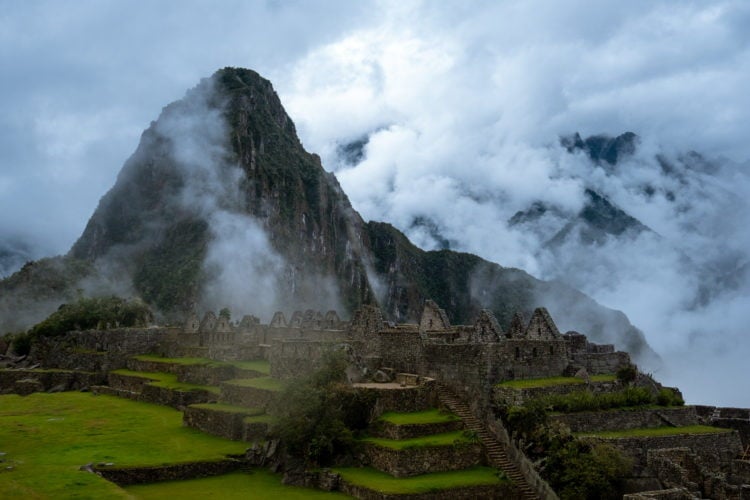
Machu Picchu

Machu Picchu building stones

Train to Machu Picchu
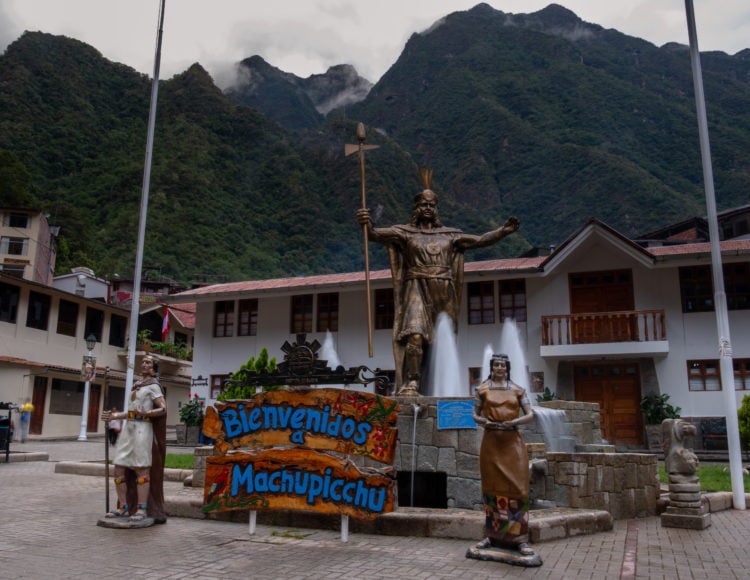
Subscribe to Our Newsletter
Keep the ride going.
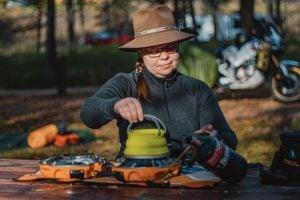
Book Review Eat Well on the Road With the Motorcycle Camp Cookbook

Save Cash Deals of the Week!

MO Review 2025 CFMOTO Ibex 450

CE This! Macna Domane Moto-Travel Jacket
Most popular, please, keep your armor in your gear, earplugs for small ears: tested, what do you know about dirt bike manufacturers, slingshot roush edition, mv agusta releases the enduro veloce, enewsletter sign up, advrider on youtube, why are electric motorcycles struggling so much - the lowdown show ep 1.

From Our Forum
American tourists stranded in Machu Picchu as deadly unrest sweeps Peru
Deadly unrest in the wake of a political crisis has left a number of American tourists stranded in Peru .
Hundreds of international travelers, including some Americans, were stuck in and around the historic city of Machu Picchu as the government raced to secure transport to the nearest airport this weekend. Photos and eyewitness accounts suggest protesters had placed rocks on train tracks leading to the Inca citadel.
Solo traveler Brian Vega, a Miami-Dade fire rescue captain, told NBC News he had been visiting the ancient mountainous town but found himself stuck when the train lines to the airport were shut.
“We’re isolated here,” he said. “The only way in is via train or the other case would be a helicopter." Vega added that he was considering hiking to the nearest town to get to the airport.
Peru declared a 30-day national emergency on Wednesday after violent protests erupted following the ousting and detention of President Pedro Castillo, who had sought to dissolve Parliament in a last-minute power grab.
The declaration “means the suspension of the rights of assembly... freedom of movement,” Defense Minister Luis Otarola announced on Wednesday, suspending the rights of the people to gather and move freely across the Andean country. An overnight curfew was also in place across major cities.
Peru’s caretaker president, Dina Boluarte, exhorted Congress on Saturday to approve early elections that could provide a way out of the crisis.
At least 20 people have died, and more than 500 demonstrators and security forces have been injured in the unrest, according to the Associated Press.
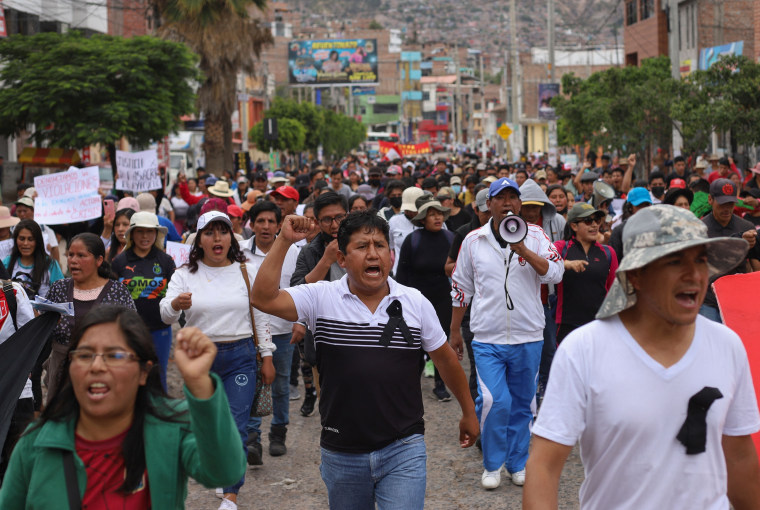
Many highways are blocked and train services have been suspended, leaving a number of tourists stranded for days at Machu Picchu with no transport from the UNESCO World Heritage site to an international airport almost 50 miles away in Cusco.
Colorado resident Tom Gray’s group had managed to take the last bus back to Aguas Calientes, the gateway town to the citadel, he told NBC News in a video interview.
He said that there were dozens still stuck at the top.
“Our guide had to bribe the protesters to move the rocks to let us go back to our hotel,” said Gray, who had first arrived at Machu Picchu on Monday night. Their group had to navigate through at least 18 roadblocks constructed by trees and boulders, he said, which were guarded by local villagers.
“There was like 200 of us rather than 5,000, which is the normal population” of the site, said Gray. “We had the whole place to ourselves.
“That was big time silver lining everywhere in being stuck here.”
All trains to and from Machu Picchu had been halted on Tuesday, PeruRail said in a statement posted on Facebook .
“The Government of Peru is organizing an evacuation via four helicopters of the most vulnerable foreign tourists from Aguas Calientes/Machu Picchu Village,” the U.S. Embassy in Lima said Saturday in a statement.
“The Peruvian government has informed the U.S. Embassy that plans are in progress to assist all travelers in Aguas Calientes/Machu Picchu Village with departure,” it said.
Almost 400 tourists from Machu Picchu were accompanied by the tourism police to Ollantaytambo District, northwest of Cusco, and then transported to the airport by bus, the ministry said in a tweet on Sunday.
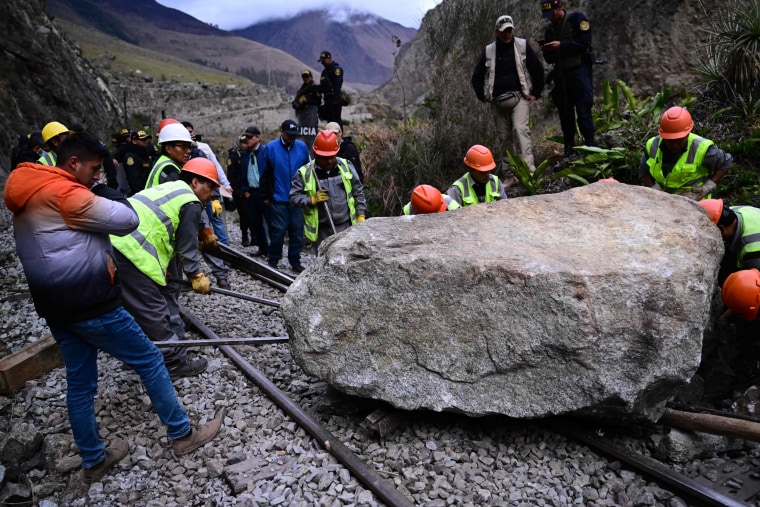
On Saturday, the ministry said it was planning to “facilitate humanitarian flights,” giving priority to the elderly and vulnerable people.
The violent unrest has prompted advisories from the U.S. State Department recommending citizens "reconsider travel" to the country, and similar guidance from other countries, including the U.K. and Spain.
Following the advisories, Daniels and McLaughlin booked their flights out of Lima for Sunday evening and Gray reserved his for Tuesday. “We can get to Cusco airport, that airport is open, which would transport us to Lima,” Daniels told NBC News, adding she would make her way once trains resumed.
"We miss our families though; we would like to get home. Our kids are all flying in to be with us for Christmas and they might have it without us," said McLaughlin.
Molly Hunter is a London-based correspondent for NBC News.
Mithil Aggarwal is a Hong Kong-based reporter/producer for NBC News.
- Environment
- Road to Net Zero
- Art & Design
- Film & TV
- Music & On-stage
- Pop Culture
- Fashion & Beauty
- Home & Garden
- Things to do
- Combat Sports
- Horse Racing
- Beyond the Headlines
- Trending Middle East
- Business Extra
- Culture Bites
- Year of Elections
- Pocketful of Dirhams
- Books of My Life
- Iraq: 20 Years On
Peru shuts parts of Machu Picchu from tourists due to erosion
Machu picchu was awarded unesco world heritage status in 1983 but has long suffered from 'overtourism'.
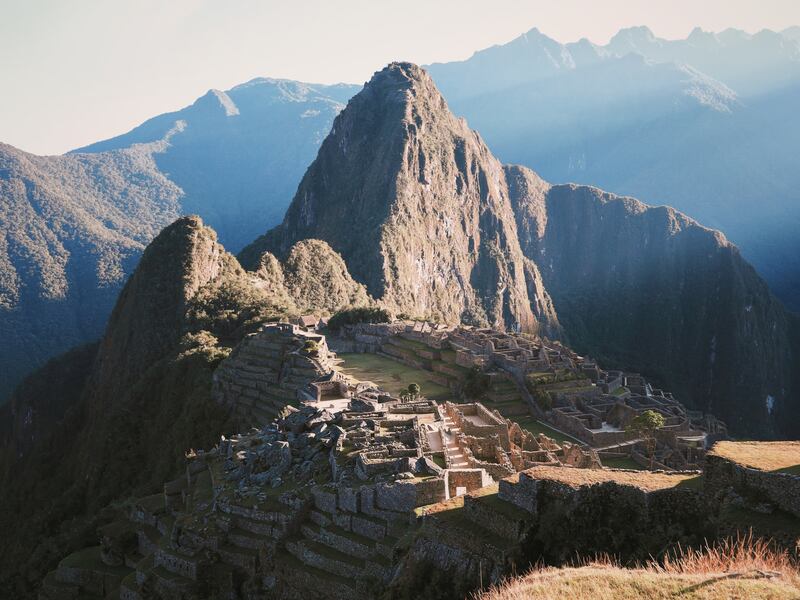
Inca Trail to Machu Picchu. Photo: Xiyuan Du / Unsplash

Peru announced on Thursday it would be suspending tourist visits to parts of Machu Picchu because of the erosion of certain stone structures that make up the Inca citadel.
The ancient Incan site is Peru’s top tourist destination, with about 3,800 people visiting per day.
However, because of the wear and tear suffered from too many tourists visiting, the country's Culture Ministry said it is suspending visits to the Temple of the Condor and the Temple of the Sun, as well as the "Intihuatana" – a carved stone structure that was sacred to the Incas.
"The damage is irreversible. We have to protect our heritage," said Maritza Rosa Candia, the ministry's delegate in the town of Cusco.
The citadel, 130 km from Cusco, was built in the 15th century as a religious sanctuary for the Incas at an altitude of 2,490 metres.
Last February, the site reopened after a month-long closure caused by violent protests against the country’s then-newly elected president. When the site was closed, demand for travel dropped dramatic for the country.
Over the past few years, Peruvian authorities have tried to find ways to manage increasing visitor numbers to the popular site which often had long lines and overcrowding, leading many tourists unable to enter.
Machu Picchu was awarded Unesco World Heritage status in 1983 and is described by the awarding body as “probably the most amazing urban creation of the Inca Empire at its height". It added its giant walls, terraces and ramps "seem as if they have been cut naturally" into the continuous rock escarpments.
However, Unesco also highlighted the challenges faced by the site, which it says requires more stringent management. “Tourism itself represents a double-edged sword by providing economic benefits but also by resulting in major cultural and ecological impacts,” said Unesco.
“The strongly increasing number of visitors to the historic sanctuary of Machu Picchu must be matched by an adequate management regulating access, diversifying the offer and efforts to fully understand and minimise impacts. A larger appropriate and increasing share of the significant tourism revenues could be reinvested in planning and management.”
With additional reporting from AFP
Checking In
Travel updates and inspiration from the past week

National Geographic content straight to your inbox—sign up for our popular newsletters here

- CORONAVIRUS COVERAGE
The collapse of tourism brings problems to Machu Picchu
As international travel disappeared, hospitality workers in Peru turned to farming and construction. COVID-19 vaccines could bring back their jobs.
In the fall of 2020, a woman walked by the Cathedral of Cusco high in the Peruvian Andes. Tourism in the area surrounding the Incan ruins at Machu Picchu have come to a halt due to COVID-19 closures, and many residents have returned to agriculture and other trades to support themselves.
Juan Yupanqui stared at a pile of mattresses, still wrapped in the plastic they came in when he bought them nearly a year ago. He wondered out loud if they would ever do more than gather dust.
The mattresses were stacked in one of the round, thatched-roof guesthouses Yupanqui built last year on his homestead in Patacancha, a small village nestled more than 11,000 feet above sea level near the colonial city of Cusco, in Peru ’s southern Andes. With their small windows and rustic furniture, the cabins were erected to expand his family’s experiential tourism business .

In the fall of 2020, Rosmery Barriga and her father Ramón Barriga removed crafts and souvenirs from their store in the Inca town of Ollantaytambo, a popular stop on the route to Peru’s Machu Picchu. COVID-19 measures kept the shop closed for months, and the Barrigas experienced thefts and break-ins.

Park ranger Tomas Huamanttica Quispe looked over the empty Moray Archaeological Center in the fall of 2020. The Inca site holding terraced depressions is believed to have served ceremonial or agricultural purposes. Like most tourist attractions near Machu Picchu, it was closed for months due to the COVID-19 pandemic.

Sebastián Tobón, owner of Supertramp Hostels in Aguas Calientes, Peru, sits in one of his empty properties in the Peruvian town adjacent to Machu Picchu. The COVID-19 pandemic has decimated the tourism economy in the area surrounding the Inca ruins, which attract more than a million visitors in a normal year.
Tourist arrivals started to pick up in 2019 after Yupanqui had worked on the property for years, with an average of five groups a month coming to spend a day or two learning how to herd alpacas; weave the colorful red ponchos that are a community trademark; and dance a quellwa tusuy , a festive step that means “dancing bird” in Quechua, the local language.
Yupanqui decided to upgrade his guesthouses after a brisk start to 2020. Then everything came to a screeching halt in March as Peru imposed a harsh lockdown in response to the COVID-19 pandemic. The French and U.S. tourists he expected that month cancelled, and his cabins have sat empty since then.
Agriculture remains the cornerstone of life in Patacancha and similar hamlets high in the Andean valleys outside of Cusco, but it is tourism that generates cash flow. For now, the visitors have stopped arriving. Yupanqui and thousands of others who worked in the multi-layered tourism industry in the region around Machu Picchu are wondering how long they will be able hold out before tourist dollars and euros return.
A tourism industry in crisis
“Tourism gave us money. Today, we have food, but we don’t have any money,” said Yupanqui, posing for a photo with a lamb, something his visitors used to do. “I get more concerned each day, because we don’t know when this is going to end.”

Weavers like Myriam Cuba Callañaupa (far left) usually demonstrate textile crafts and cooking in the village of Chinchero near Cusco. But the COVID-19 pandemic forced her and many other women who work in tourism to temporarily return to farming.
Besides homestay tourism, many of the men in Patacancha earn cash working as porters or cooks for adventurers hiking the Inca Trail, the ancient route that leads to Machu Picchu. Yupanqui, 44, did this for 18 years. Women in the community weave ponchos and other textile crafts sold in local markets.
The Yupanquis and other Patacancha families are getting through the pandemic financial crisis by selling alpaca yarn and chuño , naturally freeze-dried potatoes , to traders. They raise animals for food, though this is not possible for many of the thousands of people who worked in tourism around Cusco.
(Get a taste of why potatoes are such a hot commodity in Peru.)

In the fall of 2020, a girl stood outside her family’s store in Aguas Calientas, Peru. The Andean town near Machu Picchu is usually buzzing with tourists, but it has been nearly empty since the COVID-19 pandemic began.
Eliana Miranda, director of the Cusco government’s tourism bureau, said 92 percent of people employed in the industry—from hotel receptionists to sidewalk souvenir sellers—had lost their jobs as of August, when Cusco entered into a second lockdown.
“We have had problems in the past, but nothing as devastating to the industry as COVID-19,” she said.
According to Peru’s government, the country’s tourism business could be down as much as 85 percent for 2020. The World Travel and Tourism Council estimates that the direct and indirect economic impact of tourism in Peru in 2019 was approximately $22 billion, or 9.3 percent of the country’s gross domestic product.
Cusco’s airport received nearly 635,000 travelers in the first two months of 2020, up 16 percent from the same period in 2019. The number was only 231,726 over the next eight months, with nearly three quarters of those arrivals in March, according to Peru’s Trade and Tourism Ministry. Only 990 passengers arrived at Cusco’s airport in June, compared to 323,367 the same month last year .
Tourist visits to Machu Picchu, the Inca ruins that anchor tourism in Cusco and draw foreign travelers to Peru in general, were down 72 percent in the first half of the year. The site was receiving around 500 people a day in December, nearly all of them Peruvian tourists, down from more to 2,500 during normal times. The government eliminated the entrance fee to Machu Picchu for Peruvians to stimulate domestic tourism. The site received 1.6 million tourists in 2019.
(Learn how women porters are breaking the glass ceiling on the Inca Trail.)
Turning from tourism to other industries

In the fall of 2020, after a pause due to the COVID-19 pandemic, the train between Ollantaytambo and Aguas Calientes, Peru, reopened to local users. Aguas Calientes, nicknamed Machu Picchu Town, is the gateway to the Inca ruins, the most visited tourist destination in the country.
Miranda said there has been an exodus from the tourism industry, with people moving to other businesses or returning to rural areas to wait out the coronavirus crisis. Her office is coordinating with workers’ associations and local governments to provide assistance to people displaced by the collapse of tourism.
“We have labor training and short-term programs to help maintain income. We have been working with municipalities on job programs for people who have returned, but we think it is going to be temporary. Everyone is really waiting for tourism to return,” she said.

Fernando Condori Torres and his son Gonzalo tended to apple trees in front of the Ollantaytambo archaeological site in Cusco, Peru in late 2020. Torres, who used to work as a tour guide, had temporarily returned to farming due to COVID-19 shutdowns.

Hilda Ortiz de Orue Bautista worked maintaining and harvesting salt from the natural pools in the town of Maras. The popular Peruvian tourist site was closed for months due to the COVID-19 pandemic.
The clock, however, is ticking for many in the hospitality business.
Rubén Tello, a tour guide who speaks Spanish, English, and Quechua, hasn’t worked in the industry since he helped a group of Thai visitors rush home on March 15, 2020, as the government announced it would be closing the borders. He stayed in his apartment for two months, figuring the situation would be resolved by mid-year. When the pandemic didn’t improve, he decided to “reconvert,” the term being used for people leaving tourism for other industries.
“I thought I could wait this out, but the bills started piling up, and by July I had no choice but to find other work,” he said.
Tello said goodbye to his wife and twin 14-year old boys in the city of Cusco and headed to the nearby jungle lowlands, where he is from originally, to look for employment. He found a job driving a truck on a highway construction project. He later worked as a toll collector.
Tello came back to the city in early December, with two groups of tourists lined up and a few others in the wings. But he is realistic about his prospects. “I can’t make ends meet with a group or two a month. If the situation doesn’t pick up in January, I will go back to the construction job,” he said.
How the industry might rebuild

In the fall of 2020, a policeman asked locals to keep their social distance on the esplanade of the Church of San Cristóbal above Cusco, Peru. The spot is popular with tourists and residents for its panoramic views of the colonial city.

Maria Santos Quispe swept the cobblestones in front of her shop on Cusco’s Hatunrumiyoc Street. Though she usually stocks mostly textile art and other souvenirs, she now also carries fruit and sundries. “I have learned that I have to be attentive to all kinds of people,” said Quispe. “Before we did not offer anything to the local population.”
Sofia Arce, who runs a boutique tourism agency, Intense Peru , said the pandemic is transforming the industry. She worries that many restaurants and hotels catering to tourists could close permanently if Peru tries to simply go back to business as usual.
A former banker, Arce managed through the worst months of the coronavirus crisis with a government-backed loan from the Reactivate Peru program, and has started to rebuild as the country reopens.
Peru began allowing international air travel again in October and, in December, reestablished nearly all routes including long-haul flights from Europe and North America. Arce considers these positive steps for tourism, but believes it will take time to get back to pre-pandemic numbers.
“We have sold four tour packages for December, the first ones in nine months. It is a start, but we are going to have to be super active to regain our market,” said Arce. “There is no room for slacking off if we want to build back better.”

Before the COVID-19 pandemic, tour guide Fernando Condori Torres spent much of the year away from his home near Cusco. Due to COVID-19 lockdowns and cratering tourism in Peru, in 2020 he has spent more time with his son, Gonzalo.
A new concern for Arce and others in the industry is Peru’s current political instability—it had three presidents in the span of eight days in November—and rising social demands created by the pandemic-ravaged economy. Peru’s economy contracted by 13.4 percent in the first 10 months of the year; the hospitality industry was down 54 percent from to 2019, the most significant drop in the calculation by the national statistics agency. The national unemployment rate is 15.1 percent .
Machu Picchu, just starting to recover, was forced to close again briefly in mid-December when communities along the train that ferries tourists to the ruins called a strike and blocked the tracks, demanding lower prices for locals who also use the service.
(Explore Peru beyond Machu Picchu via sacred rivers, bike trails, and otherworldly sand hills.)
“The political problems are adding a new dimension to the problems here. I think tourists could stay away a little longer if we had instability due to the pandemic,” said Fabricio Zelada, who recently moved back to Cusco after years of living in the country’s capital, Lima.
Peru’s trade and tourism minister, Claudia Cornejo, recognizes that the industry still faces a tough climate, estimating that it might take two or three years for it to return to pre-Covid traffic. The government’s idea is to use the crisis as a reset button so that tourism can “return differently.”
Cornejo said the conditions created by the lack of tourists today should be used by industry “to concentrate on improvements, making upgrades needed so that when receptive tourism begins, we are ready to offer even more than before.”
She sees the kind of experiential, more sustainable tourism offered in places like Patacancha as part of a trend that was gaining ground prior to the pandemic, with tourists wanting to go beyond observing a culture to experiencing it. She said the pandemic might even give it a boost.
“I think experiential tourism is going to continue. COVID-19 interrupted it, but will not stop it,” she said.
Related Topics
- SUSTAINABLE TOURISM
- AGRICULTURE
- ARCHAEOLOGY
You May Also Like

These remote Inca ruins rival Machu Picchu

Explore Inca life beyond Machu Picchu on this South American trail
Free bonus issue.

Meet Rodrigo Pacheco, the Ecuadorian chef shining a light on native ingredients

These historic Greek sites shed fresh light on Alexander the Great’s lost kingdom

In Tajikistan, discover the ruins of a once mighty Silk Road kingdom

One of Italy’s most visited places is an under-appreciated wine capital

20 of the coolest travel adventures for 2024
- Environment
- Paid Content
History & Culture
- History & Culture
- History Magazine
- Mind, Body, Wonder
- Terms of Use
- Privacy Policy
- Your US State Privacy Rights
- Children's Online Privacy Policy
- Interest-Based Ads
- About Nielsen Measurement
- Do Not Sell or Share My Personal Information
- Nat Geo Home
- Attend a Live Event
- Book a Trip
- Inspire Your Kids
- Shop Nat Geo
- Visit the D.C. Museum
- Learn About Our Impact
- Support Our Mission
- Advertise With Us
- Customer Service
- Renew Subscription
- Manage Your Subscription
- Work at Nat Geo
- Sign Up for Our Newsletters
- Contribute to Protect the Planet
Copyright © 1996-2015 National Geographic Society Copyright © 2015-2024 National Geographic Partners, LLC. All rights reserved
Stay up to date with notifications from The Independent
Notifications can be managed in browser preferences.
UK Edition Change
- UK Politics
- News Videos
- Paris 2024 Olympics
- Rugby Union
- Sport Videos
- John Rentoul
- Mary Dejevsky
- Andrew Grice
- Sean O’Grady
- Photography
- Theatre & Dance
- Culture Videos
- Food & Drink
- Health & Families
- Royal Family
- Electric Vehicles
- Car Insurance deals
- Lifestyle Videos
- UK Hotel Reviews
- News & Advice
- Simon Calder
- Australia & New Zealand
- South America
- C. America & Caribbean
- Middle East
- Politics Explained
- News Analysis
- Today’s Edition
- Home & Garden
- Broadband deals
- Fashion & Beauty
- Travel & Outdoors
- Sports & Fitness
- Sustainable Living
- Climate Videos
- Solar Panels
- Behind The Headlines
- On The Ground
- Decomplicated
- You Ask The Questions
- Binge Watch
- Travel Smart
- Watch on your TV
- Crosswords & Puzzles
- Most Commented
- Newsletters
- Ask Me Anything
- Virtual Events
- Betting Sites
- Online Casinos
- Wine Offers
Thank you for registering
Please refresh the page or navigate to another page on the site to be automatically logged in Please refresh your browser to be logged in
From lost city of the Incas to tourist trap in 100 years
The huge number of people who visit machu picchu every year are threatening the site's very survival. simeon tegel reports, article bookmarked.
Find your bookmarks in your Independent Premium section, under my profile
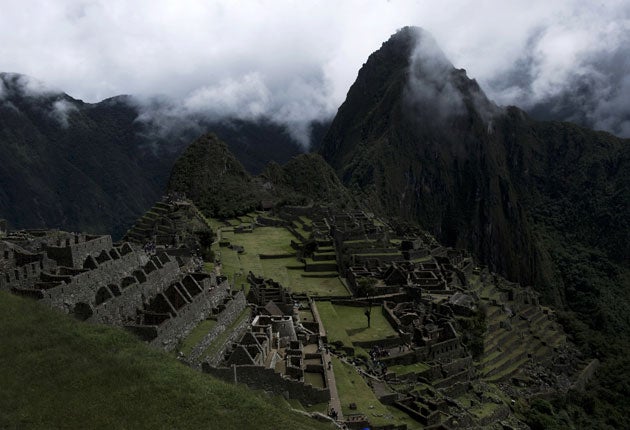
The latest headlines from our reporters across the US sent straight to your inbox each weekday
Your briefing on the latest headlines from across the us, thanks for signing up to the evening headlines email.
As Hiram Bingham hacked his way through remote Andean cloudforests in search of a lost Inca citadel in 1911, little could the American adventurer have known of the tourism juggernaut that his archaeological expedition would unleash – or how it might threaten his breathtaking find.
Now, Peru is gearing up to mark the centenary of Bingham's rediscovery of Machu Picchu with a series of glitzy events on 6 and 7 July. Sponsored by Coca Cola, the festivities will include international broadcasts of a son-et-lumière show and a concert expected to feature the Spanish tenor José Carreras.
But many in the archaeological community are deeply worried about the pressures on Machu Picchu from the 2,000 visitors it receives every day and the rapid growth of over-priced hotels, tacky souvenir shops, fast-food restaurants and other unregulated infrastructure around the citadel and along the Sacred Valley that links it to Cusco, the former Inca capital.
"In 10 years' time, the valley will be like a giant amusement park, like Disneyland," warns Jose Canziani, an expert in the strategic development of archaeological sites and professor at Lima's Catholic University.
The World Heritage Committee of Unesco, the United Nations cultural organisation, agrees. In 2008, it voiced its "grave concern" regarding the mismanagement of Machu Picchu, and in 2009 expressed its frustration at Peru's refusal to allow the ruins to be placed on a list of endangered sites. The panel highlighted problems from the wearing away of the original stone paving to the increased risks of landslides caused by deforestation as a result of the chaotic construction boom.
The committee is due to report next month on Peru's progress. Anything less than a ringing endorsement could prove highly embarrassing for President Alan Garcia's administration.
The Peruvian authorities have made some headway. The government banned the helicopter overflights enjoyed by some of Machu Picchu's more affluent visitors. Yet problems persist. In January last year, landslides in Aguascalientes, the tourist trap at the base of the mountain on which Machu Picchu sits, killed five people and left several thousand sightseers stranded for days. Machu Picchu remained closed for three months. And there has been no response to the erosion of the original stone paving. Wooden walkways or a requirement for visitors to wear rubber-soled shoes are two obvious solutions, says Jeff Morgan, executive director of the Global Heritage Fund, a San Francisco-based group working to protect archaeological remains in the developing world, but there has been no word from the Machu Picchu research team run by Cusco's regional government.
Further down the Sacred Valley, tourist traffic over-runs Ollantaytambo, an Inca fortress that was the scene of one of the Andean empire's few military victories over the invading Spaniards. Buses clog the narrow, cobbled streets of the village.
"Peru has been selling this idea that we are this amazing tourist destination but the reality is that we are not attending adequately to our visitors," complains Joaquin Randall, the manager of El Albergue, the town's oldest hotel, founded in 1925.
Suggestions by Ricardo Vega Llona, the businessman presiding over the centenary celebrations, that more people should visit Machu Picchu have been met with alarm by conservationists, who argue tourist traffic needs to be directed to other sites. Peru has 100,000 identified sites of archaeological interest. But only 2,800 have been officially signposted and marketed as attractions, while as few as 200 are protected with barriers or personnel.
"Everyone wants to go to Machu Picchu but there are 25 other sites in Peru that are just as amazing," Mr Morgan told The Independent. Channelling visitors to these other sites would also better distribute the economic benefits of tourism in a country where nearly half of rural residents still do not get enough to eat.
Yet some of Peru's greatest ruins, such as the imposing mountain fortress of Kuelap in northern Peru, have no road access and require strenuous treks of several days.
Meanwhile, the directorate of archaeology in Peru's recently-founded Culture Ministry struggles with an annual budget of less than £1m and just 100 employees. According to Elias Mujica, a consultant on the development of archaeological sites, the directorate is "crippled" despite Peru's immense archaeological resources and the economic opportunity they provide.
"Just imagine it," sighs Hector Walde, head of the directorate, when it is pointed out that the equivalent agency in Mexico has around 2,500 staff working to protect Aztec, Maya and other ruins. The backlog of issues piled up in his inbox includes looting, uncontrolled urban development and inappropriate reconstruction by foreign archaeological teams.
Last month, authorities removed 4,500 tons of rubbish dumped by local communities inside the perimeter of the World Heritage Site Chan Chan, a spectacular pre-Inca adobe city on the Pacific coast. And farmers have been attempting to seize land at Caral, just north of Lima, a complex from 2,600BC and one of the Americas' oldest known inhabited sites.
One exception to the troubling picture is the Moche Route, a successful new tourist circuit on Peru's northern coast, linking ruins from the Moche people, famous for their lewd ceramics. The sites, including the giant Pyramids of the Sun and the Moon, are well conserved and local communities were involved in its strategic planning.
Yet even here there are serious problems, with unprotected Moche ruins providing one of two archaeological looting hotspots in Latin America. The other, in Guatemala, sees the smuggling of an estimated 1,000 Maya ceramics a month, with a market value of more than £6m. No one seems to have an equivalent figure for Peru although Mr Walde estimates there are around 25,000 people involved in the trafficking nationally, most of them impoverished locals who earn a pittance, while a handful of middlemen make millions. The margins are comparable to the drugs trade, with retail prices around 1,000 times greater than the amount paid to the looter.
"Looting has gone on for centuries. It is a tradition in Peru," Mr Walde says. "There is no awareness that looting tombs is prohibited. It is not socially censured."
The courts, meanwhile, lack teeth. Peruvian law provides for sentences of up to eight years for illegally trading artefacts but prosecutors are usually unable to prove a suspect was knowingly involved in ransacking a marked archaeological site.
For Bingham, his rediscovery of Machu Picchu heralded a triumphant return to America, where he eventually became a senator and, after his death, the model for the Indiana Jones movies. Yet the legacy of his momentous find is less clearcut for Peru. As the centenary celebrations get under way, a questionmark continues to hang over the government's ability to protect the archaeological riches many regard as a global as well as a national patrimony.
Cradle of civilisations
* The Inca empire, which started off as a tribe in what is now Peru and established a dominion that stretched from modern-day Chile to Colombia, actually only lasted 200 years yet was the culmination of millennia of civilisation in the Andean region. The diversity of cultures rivalled that of the Mediterranean basin.
* Cuzco was the capital of the Inca empire from which kings ruled. The empire was tied together by an extensive road system. Inca architecture is distinguished by the use of stones sculpted to fit without the use of mortar.
* Known as fearsome warriors, the Incas built their empire through both force and diplomacy. But it was destroyed when Spanish invaders, led by Francisco Pizarro, arrived in Peru in 1532. The Incas were unable to match the firepower of the Europeans, and the explorers also brought with them diseases such as smallpox that devastated the indigenous people.
* Peru is today littered with the stunning ruins of cultures that scholars know little about. Among the most notable are the Paracas people from the deserts of Peru's southern coast in about 500BC, who made dazzling textiles; the warlike Wari empire from the southern Peruvian Andes, from 500AD to 1000AD; the Moche, from 100AD to 800AD; and the Chachapoyas people of Peru's northern cloudforests, who left a mausoleum full of mummies chiselled into a cliffside.
* The Incas worshiped a number of gods. The most important of these was Inti, the sun god. According to Inca belief, the Inca emperors descended from him.
Other tourist sites at risk
Angkor Wat, Cambodia
Illegal pumps withdrawing millions of litres of groundwater every day from beneath the city of Siem Reap may threaten the stability of the nearby ancient temples of Angkor Wat, Unesco says. Growing numbers of tourist hotels are blamed for such high water demand. More than 800,000 people visited Angkor Wat in the first nine months of 2010 – 24 per cent more than in the same period the year before.
Pompeii, Italy
The 2,000-year-old House of the Gladiators in this ancient Roman city collapsed last November, pictured right, prompting an outcry from historians who fear the government is neglecting Italy's priceless national treasures. Three chunks of mortar also fell off Rome's Coliseum in May last year.
Everest Base Camp, Nepal
Refuse, medical waste and an ever growing number of tourist cafés are blamed for creating the "highest junkyard in the world" at the popular trekking destination. Conservationists continue to call for a temporary closure of the site in an attempt to reduce visitor numbers and their negative environmental impact.
Grand Canyon, Arizona, US
Noisy air tours and pollution are putting the Grand Canyon National Park at "grave risk", according to a report released last year. Every year, more than 400,000 tourists fly above the canyon in helicopters and light aircraft, which are blamed for ruining the park's natural soundscape.
Great Barrier Reef, Australia
The world's largest reef system, housing over 400 species of coral and 2,000 species of fish, is threatened by a combination of climate change, rising sea levels and shipping. Last year the Chinese trawler Shen Neng 1 destroyed over 3km of coral when it ran aground.
Join our commenting forum
Join thought-provoking conversations, follow other Independent readers and see their replies
Subscribe to Independent Premium to bookmark this article
Want to bookmark your favourite articles and stories to read or reference later? Start your Independent Premium subscription today.
New to The Independent?
Or if you would prefer:
Want an ad-free experience?
Hi {{indy.fullName}}
- My Independent Premium
- Account details
- Help centre
Avoid the tourist traps and see a different side of Peru
We lay out a plan for skipping machu picchu and instead find ways to support local artisans and women-run businesses outside the big peruvian destinations., by mai nguyen, published: monday 25th november 2019.
“Does this look good on me?” I ask a fellow traveller. I’m draped in a luxuriously soft scarf made of local alpaca wool, but I can’t decide if I want to get the pink and black diamond-patterned scarf or the purple one with three teal stripes going down the middle. I count the Peruvian sol in my wallet to see if I have enough to buy both but I don’t. I have to pick just one.
I’m at a market in Ccaccaccollo, a small village in the Sacred Valley of Peru, and there are hundreds of alpaca garments here. There are sweaters for babies, scarves for men and socks for all sizes of feet. If shoppers aren’t convinced of the material’s authenticity, all they have to do is look left to see several alpacas casually roaming the grounds with bright yarn tassels dangling from their ears.
If the free-range alpacas didn’t already give it away, this is not your typical market. As soon as we step off the bus, we are greeted by a cheerful mass of women who embrace us with a kiss on each cheek. They are wearing long black skirts embroidered with floral patterns, bright red cardigans over ruffled blouses and braided pigtails underneath round mauve hats.
Some of the children grab our hands and lead us to the market. We’ve been here a few minutes but this place already feels a world away from Lima where we were the day before. There’s nothing but Andean mountains all around us and Cusco, the region’s bustling capital, is 24 kilometres away. For a market it feels very intimate, like you’re in somebody’s backyard, and the only travellers are the people I came with.
Most tourists typically skip this quiet slice of Peru and go straight to the Incan ruins of Machu Picchu, located 128 kilometres west of here. Not us. I’m travelling with Planeterra Foundation , a non-profit organization established by the Toronto-based travel company G Adventures . They’ve taken us off the beaten path to show us this little-known village where roughly 60 Quechua women have revitalized a 500-year-old Incan weaving technique that came very close to extinction.
As visitors to Machu Picchu soared from 95,000 to 1.1 million, Ccaccaccollo barely enjoyed any of the revenue
After Peru’s guerrilla war ended in the 1990s, an influx of tourists began flocking to Machu Picchu and the surrounding areas. Certain communities like Urubamba and Ollantaytambo prospered while those not situated along the tourist route were shut out from the lucrative tourism industry. As visitors to Machu Picchu soared from 95,000 people in 1992 to 1.1 million in 2012, Ccaccaccollo barely enjoyed any of the associated revenue. As a result, residents were forced to go where the tourist dollars were, leaving behind their village and the ancient traditions they grew up with.
In 2005, Planeterra sought to redistribute the tourism-generated wealth by kick-starting the Women’s Weaving Co-op in Ccaccaccollo. Indigenous families were able to return to their village, relearn old weaving techniques, and sell alpaca garments to tourists who visit the village as part of G Adventures’ Sacred Valley Tour. The village welcomes about 1,000 visitors a year, generating income for its Indigenous families and empowering the women who make the clothing. Before the co-op existed, some of the Quechua women had never held money in their hands before, relying instead on the exchange of agricultural goods to purchase day-to-day necessities. Thanks to the co-op, they’re financially self-sufficient.
“With the money that I am making, I am able to send my child to university,” says Igidia Huanca Qquerar.
Heartwarming stories like these are enough to make everyone whip out their wallets, but the quality of the clothing has just as much to do with the brisk sales. We are led through every step of the process, and it is like something out of a crafter’s dream. There are baskets of raw alpaca wool everywhere. In the middle of the grounds, a handful of women sit on the grass under a straw-roofed hut with their legs splayed out as their hands entwine multi-coloured threads. Off to one side, elders supervise young girls as they spin fibres into a fine yarn using the weight of a drop spindle.
With these bugs, the Quechua women are able to achieve a range of shades, from cherry red to royal purple
In another area, balls of alpaca wool are boiling in steaming pots of bright red dye. I find out it’s not mass-produced acid dye they’re using. Instead, the red colouring comes from cochineal, a small insect that has been dried in the sun and grounded to a fine powder. With these bugs, the Quechua women are able to achieve a wide range of shades, from cherry red to bubble gum pink to royal purple. Throw in a splash of lime and the cochineal-dyed yarn can magically morph into the colour of a pumpkin. The women are able to create nearly every shade of the rainbow by making use of what grows in their garden, such as ch’illca leaves for green, tara bean pods for blue, and q’olle flowers for yellow.
It takes several weeks to make one scarf by hand whereas a machine could get the job done in a matter of days. So why do it the long way? “They want to keep their ancient knowledge of textiles alive and pass it down to young generations so it can be preserved forever,” says Joel Callanaupa, a Planeterra project manager.
The co-op is proof that if done properly, tourism can be used to distribute wealth to places that need it the most and not just to the obvious players such as hotels, tour operators, and travel agents.
Luckily, there were plenty more ways for us to responsibly spend our money. Our next stop was the Parwa Community Restaurant , another social enterprise that was established by Planeterra in 2014. It’s nestled in the rural community of Huchuy Qosqo in the Sacred Valley. The restaurant is surrounded by lush gardens and emerald-green mountains. Roughly 65 Indigenous families call this area home and nearly every one of them has been trained to work at the restaurant, building skills from scratch in everything from cooking and serving to accounting and management. Employees also get insurance and monthly salaries and profits from the restaurant go back into the community. In fact, enough money was made from the restaurant that they were able to build a computer centre for children, open up a community garden and buy containers of clean water for every family.
Once you taste the Peruvian dishes on offer, it’s easy to see how they’ve been so successful. One by one, our table filled up with warm tamales accompanied by fresh salsa, a fried-rice-inspired dish made with sautéed quinoa, and a strawberry-infused gelatinous pudding. The food was so flavourful I had to compliment the head chef, Rocío Quispe Machaca, who I found in the kitchen washing up some pots. “My life has changed through this project. Before this, I was making enough to just get by. Now I am able to send my children to school and live in a nice house,” she said.
Machaca is among the 35 women who have been trained to work at the restaurant. Before Parwa was built, many of them struggled to find non-agricultural work much less leadership roles. Now, they’re earning an income and finally benefiting from all the tourists that visit the area.
If you’ve got a big appetite, Parwa Restaurant is a great place to make a difference with your dollars. There’s even a small shop right outside the restaurant that sells herbal tea made from medicinal plants that have been hand-picked and packed by a group of 12 women from Parque de la Papa (translation: Potato Park) in the Pampallacta community of Peru.
This is where I found myself after finishing my dessert and in desperate need of a post-meal walk. The sun had just gone down and there were barely any lights in the shop, so I used the flashlight on my iPhone to check out the goods. They had a variety of tea to choose from, some I’ve never even heard of before like muña, which is a mint-like herb that grows in the Andes and is commonly used as a digestive tonic. I purchase a couple of boxes and pray it’s something I’m allowed to bring back to Canada. Luckily, it was.
At the end of the trip, I check how much Peruvian sol I have left. There’s only a couple of coins that barely add up to one Canadian dollar. But I don’t feel bad about it. Unlike previous trips where I’m ridden with guilt over all the shopping I’ve done, I feel good coming home with an empty wallet because I know my money has been well spent on women-run enterprises.
On the flight back, I wrap myself in the pink alpaca scarf that I had purchased in Ccaccaccollo and get ready to doze off until I notice a piece of tape stuck to the soft fibres. The name of the weaver is written in blue ink: Juliana. With the scarf shrouding me in warmth, I sleep soundly the whole way home.
planeterra.org
- International edition
- Australia edition
- Europe edition

Machu Picchu train line reopens after protesters strike deal to readmit tourists
Access to Incan site in Peruvian Andes restored after dispute over new electronic rail ticketing system
Peruvian authorities have reopened the train route to Machu Picchu, after an agreement was struck to end more than a week of protests that had blocked access to the famed Incan site and stranded tourists .
PeruRail said in a statement a partial service had restarted on Wednesday and that a regular service would return on Thursday from the city of Cusco to Aguas Calientes, a town near the archaeological site.
The protests began late last week over a new centralized ticketing system, leaving hundreds of tourists unable to reach the ancient ruins high up in the Andes.
Protesters said they feared the new electronic ticket sales platform would hurt local businesses by shifting the administration of ticket sales to one private company authorized by the ministry of culture.
The blockade had left streets, hotels and restaurants around Peru’s most famous tourist attraction almost deserted.
“This seems like the time of the Covid-19 pandemic – you hardly see any people,” said Roger Monzón, an employee at the Inkas Land hotel in the Machu Picchu district, an 18-room building currently housing only two tourists from Portugal.
The two sides signed an agreement on Wednesday that will see a transition period to the new platform.
“We have to move forward to reactivate our economy,” Peru’s minister of culture, Leslie Urteaga, told a local radio station.
Agencies responsible for the preservation of the Unesco world heritage site have warned about overcrowding and tickets being oversold, leading authorities to find new ways to control visitor numbers as travel rebounds in the wake of the Covid pandemic.
- Machu Picchu, Peru
- Rail transport
Most viewed

Machu Picchu Hiking Tips – How To Hike the Inca Trail
Written By: Mark Whitman
Updated On: December 30, 2021
The Machu Picchu hike along the Inca Trail of Peru draws millions of travelers every year. It’s one of the most iconic treks on our planet. For myself, hiking to Machu Picchu was the highlight of my South American journey .
Yes the Inca Trail to Machu Picchu is busy, and yes, it feels like a tourist trap, but there is still no escaping the magic that one feels when standing among the ancient stones. This feeling is only enhanced by trekking up the original pilgrimage route to reach the site. The route we now call the Inca Trail.
To help you prepare for your perfect Inca Trail experience, I have written my top 8 tips to help you on your Machu Picchu hike .
Table of Contents
Hiking The Inca Trail to Machu Picchu Tips
1. best time to hike machu picchu.
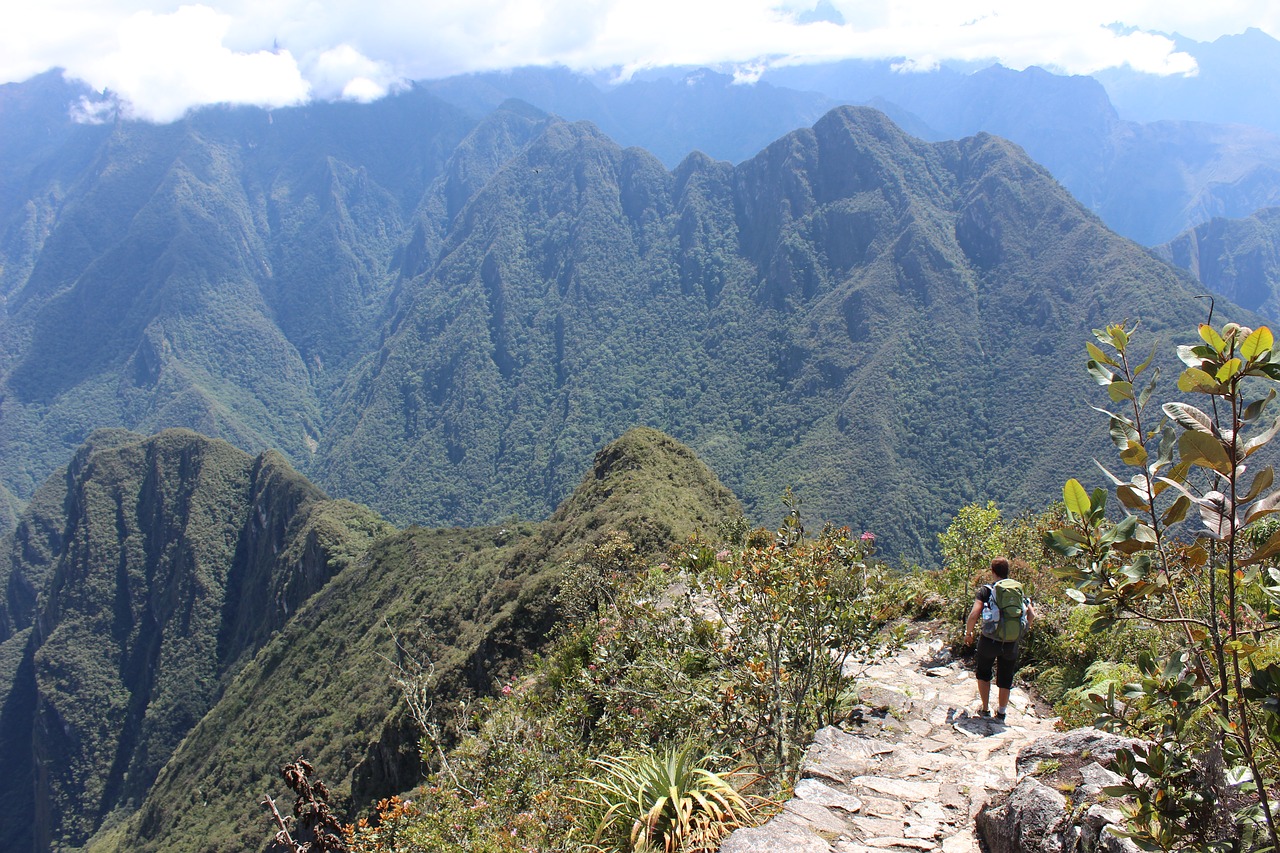
In the Peruvian Andes, you generally get two seasons.
- April till October is considered the dry season.
- November through to March is considered the wet season (although warmer).
- May to September is considered the best time to trek because of the dry days. But I disagree.
April to Oct: Tourists literally flock to Machu Picchu during the dry season and this can be somewhat off-putting.
Nov – March: Yes, the wet season is wet, but if you can get past that, then you’ll have a far more tranquil experience hiking to Machu Picchu than you would during the peak season.
The Best Time: My favorite time is late March when the days are getting drier and the place isn’t swarming with tourists.
Unless you enjoy getting soaked avoid trekking in December and January.
The Inca Trail is closed in February.
2. Book your Machu Picchu hike early
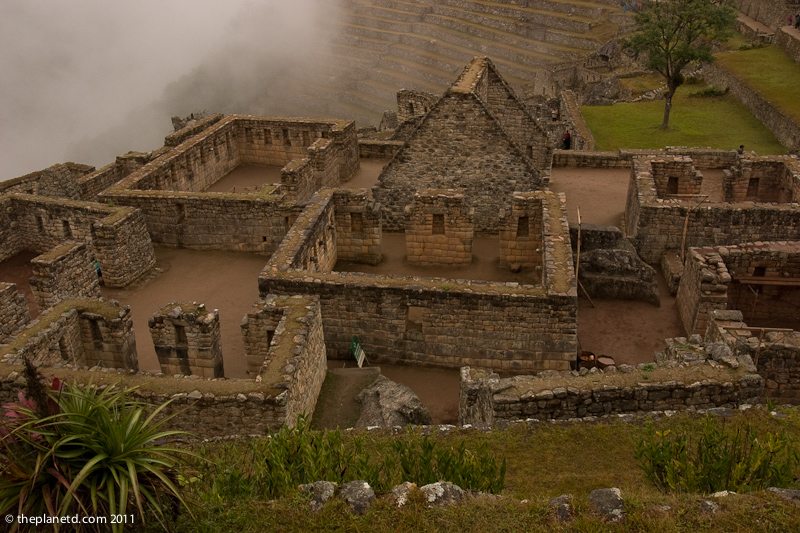
Book early. I really can’t stress this enough.
While Machu Picchu allows thousands in a day, the Inca Trail does not.
Only a strict amount of tourists are allowed on the trail to Machu Picchu each day.
Book 6 Months in Advance
To make sure you get your ticket, you’re going to want to book 6 months in advance if you’re planning on trekking during the peak season.
Even if you plan on going during the wet season you’ll need to book at least 3 months in advance.
The last time I trekked the trail I witnessed a Dutch couple in floods of tears because they hadn’t booked in advance.
Alternate Hikes to Machu Picchu
If worst comes to worst, you can always trek another route to Machu Picchu such as the Inca Jungle Trek or the Lares Trail.
Only the Inca Trail requires you to book early.
3. Train before your trek to Machu Picchu
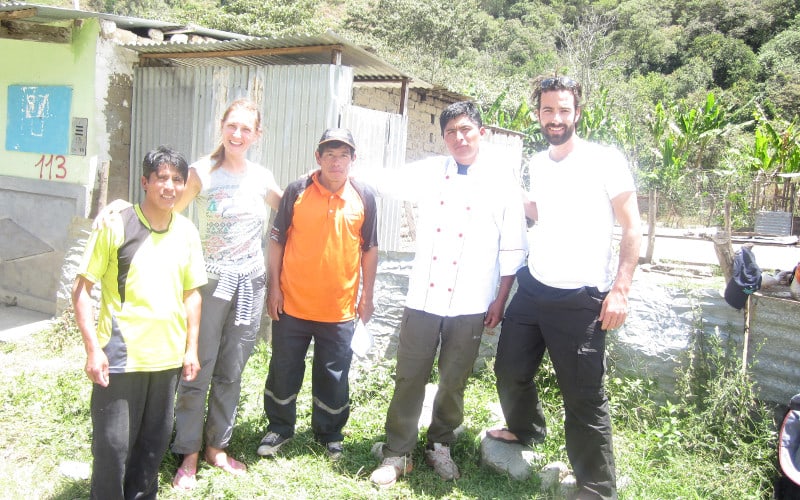
The classic Machu Picchu trek takes only 3 days. H But you’ll be trekking for nearly 7 hours each day which does take it out of you. On top of this, you need to cross Dead Woman’s Pass standing at 4,215m (13,828 ft).
I’m a fairly fit young chap, but that pass had me breathing so hard I had to stop several times. No, you don’t need to be superman to complete the trek, but having a decent fitness level will increase your enjoyment that much more.
I would advise doing as many day treks as you can in the months leading up to your trek to build up your cardio level.
4. Acclimatize properly to the elevation
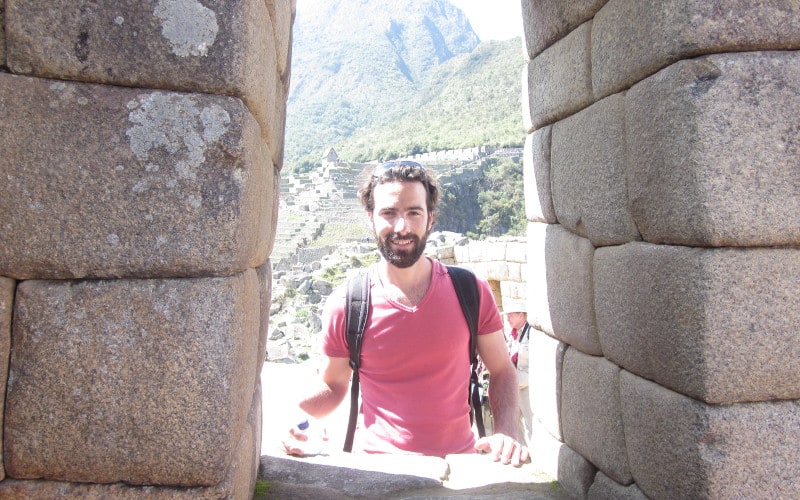
Landing in Cusco I felt absolutely nothing. I took a taxi to my hostel, I had a nice dinner and I went to sleep. But the next morning was another story.
Altitude Sickness on the Inca Trail
I awoke with a splitting headache and stayed in bed for most of the day. The kind lady who ran the hostel made me some nice coco leaf tea, which apparently wards away altitude sickness. Although it didn’t cure me, I did feel a little better.
Tips to acclimate to altitude
If I was to go back I would have taken a bus down into the Sacred Valley, stayed in the beautiful town of Ollantaytambo, and acclimatized properly over a few days before tackling the Inca Trail.
5. Get the right gear for The Inca Trail
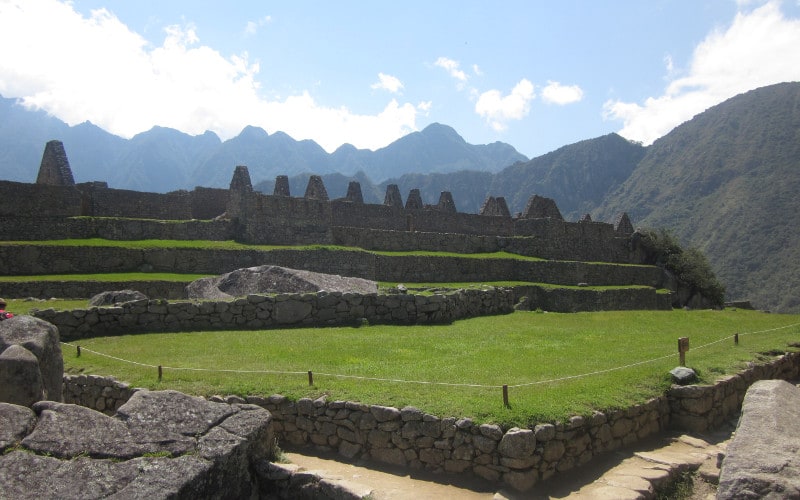
The temperature actually stays fairly level throughout the year, hanging around the 20-degree mark during the day and 4/5 degrees at night. If you’re trekking during the dry season I would still bring a lightweight waterproof breathable jacket, and if you’re trekking during the wet season then it’s a must.
On top of this, you need to avoid cotton clothing and bring trekking clothes that are made from a high-wicking material.
I remember feeling constantly damp in the muggy atmosphere and was super relieved not to be wearing jeans or cotton shirts. Make sure you bring a good fleece, a warm jacket and base layer for the cold nights and mornings.
6. Pack insect repellent
I made the serious mistake of not bringing insect repellent on my trek to Machu Picchu. The flies on the trek are big, bad and annoying. The bites I obtained on the trek became itchy and quite painful and did not disappear for a few months!
Make sure to get a reliable repellent brand that has a high Deet content – greater than 90% is ideal. Chuck a fresh coating on twice a day and stay vigilant.
7. Get comfy at night
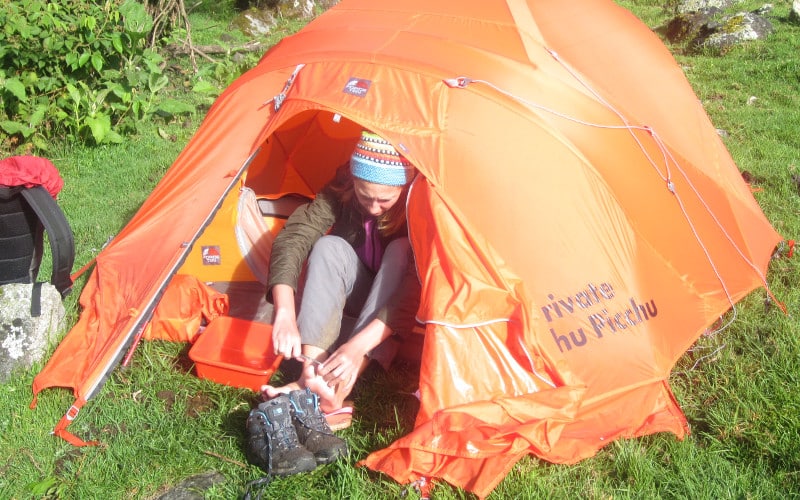
A good night’s sleep on the Inca Trail is a must. Walking for 7 hours a day requires all your strength and you seriously don’t want a sleepless or uncomfortable night during the trail. Having proper gear and equipment to rest well at night is a must.
I chose to bring my own warm sleeping bag, blow up pillow and Thermarest mat. Having my own sleeping bag was a great feeling and the others in my group looked longingly at my Thermarest mat, which kept me nicely comfortable on the hard ground.
What to pack for Hiking the Inca Trail:
- Warm lightweight sleeping bag
- Fleece jacket or lightweight down jacket
- a breathable waterproof outer shell
- This socks – for sleeping
- Merino Wool base layer
- Good hiking boots that are broken in in advance
I can’t stress how important it is to choose the right sleeping gear to keep you comfortable. w Whether it’s an inflatable pad or foam mattress choose one that’s small and light enough not to be too much of a burden on the trail.
Warning – you may get jealous onlookers.
8. Enjoy the Machu Picchu trail
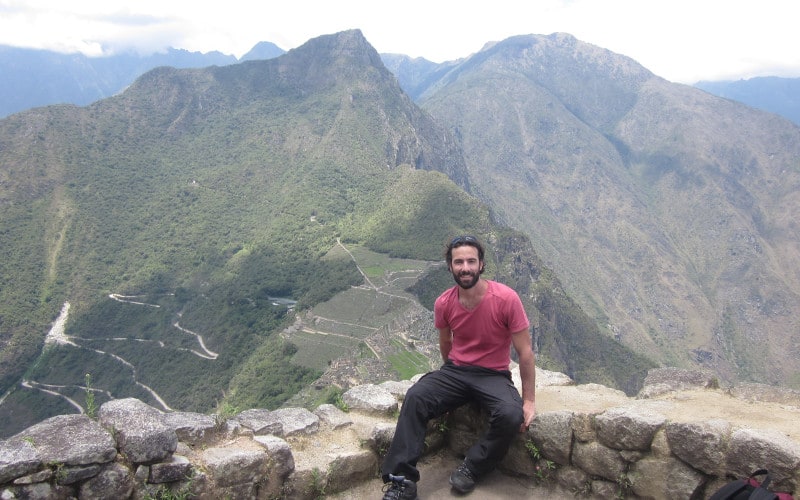
It may sound obvious, but I saw so many people huffing and puffing and generally looking down at their feet as they walked.
Remember where you are, remember to stop and take in the views, and remember to enjoy the Machu Picchu hike .
Yes, you may get tired, yes, you may get wet and uncomfortable, but you will probably only do this amazing experience once – so make the most of it.
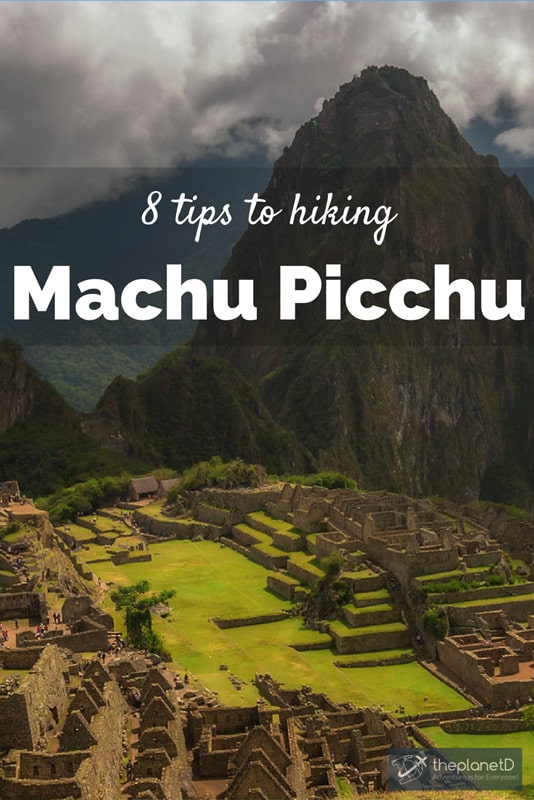
The ancient ruins, deep rainforest and perfectly sculptured stone continue to amaze and delight visitors from all over the world.
Planning resources for your next Peru Vacation
- Rainbow Mountain: What To Expect When Hiking Rainbow Mountain in Peru
- Food: 5 Authentic Cusco Restaurants Where You Can Eat Like A Local
- Cusco: Top Three Little Known Hiking Day Trips in Cusco, Peru
- Iquitos : Things to do in Iquitos, Peru – A Gateway to the Amazon
- Amazon Cruise: What to Expect on an Amazon River Cruise – Life on the River
- Amazon River: 10 Reasons to Visit the Amazon River
- Facts About Peru: Fun Facts About Peru You Never Knew
- Things to do: 21 Of The Best Things To Do In Peru In 2021
- Paracas: Paracas Peru – Adventures In The California Desert
Travel Planning Resources
Looking to book your next trip? Why not use these resources that are tried and tested by yours truly.
Flights: Start planning your trip by finding the best flight deals on Skyscanner
Book your Hotel: Find the best prices on hotels with these two providers. If you are located in Europe use Booking.com and if you are anywhere else use TripAdvisor
Find Apartment Rentals: You will find the cheapest prices on apartment rentals with VRBO .
Travel Insurance: Don't leave home without it. Here is what we recommend:
- Allianz - Occasional Travelers.
- Medjet - Global air medical transport and travel security.
Need more help planning your trip? Make sure to check out our Resources Page where we highlight all the great companies that we trust when we are traveling.
You May Also Like
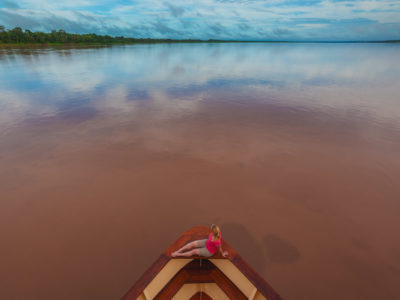
18 Interesting And Fun Facts About Peru
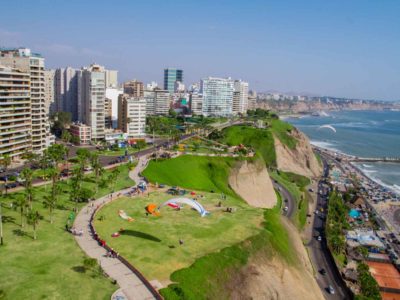
25 Best Things to Do in Lima, Peru in 2024
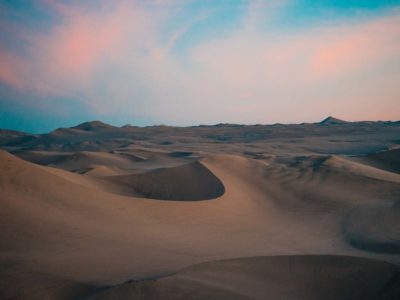
18 Amazing Reasons To Visit Peru
About Mark Whitman
Mark Whitman is a high altitude adventure junkie. He has extensive knowledge of the famous trekking trails in Nepal - Everest Base Camp and the Annapurna Circuit - and spent two months in Peru trekking all the Inca trails to Machu Picchu. Through his adventures, Mark has written some of the most popular online guides to all these destinations Machu Picchu Trek Guide. He also writes at Sleep Studies. Follow Mark at MachuPicchuTrek
Join thousands of others who get our monthly updates!
Leave a comment cancel reply.
Save my name, email, and website in this browser for the next time I comment.
9 thoughts on “Machu Picchu Hiking Tips – How To Hike the Inca Trail”
I love your blog and the way you write it; a tip when I travel is that the climate of Machu Picchu is very changeable, and they even told me that I had to be lucky to be able to see it in all its splendor and they recommended some tips and my trip was unique and unforgettable.
Thanks for taking the time to write this. lots of info, that I’m sure is going to be useful. looking forward to this excursion. Are their any trekking company you recommend a solo guy booking through?
Are there any recommendations on selecting the best tour guides? I simply have no idea where to begin
Machu Picchu is both a cultural and natural UNESCO World Heritage Site. It is the site of an ancient Inca city, high in the Andes of Peru. Since its discovery in 1911, growing numbers of tourists have visited the site each year. As Peru’s most visited tourist attraction and major revenue generator, it is continually exposed to economic and commercial forces. Discover the ancient Incan citadel of Machu Picchu with expert private Photographer Guide Photo Tours Peru, who’ll make the ruins come alive with history, and enjoy the scenery of the Sacred Valley, Inca Trail, Ausangate Hike, Salkantay trek, Lares trek. You’ll get up close to ancient cultures and awe-inspiring natural wonders in the company of local Guides whose passion for their country is contagious. Your luxury trip to Peru can include as much or as little as you like. I have planned to go for a trip to Peru with the help of a premier adventure company, an accomplished with the Photo Tours Peru guide.
Thanks & regards Fadahunsi
Wonderful post. I loved to travel to Machu Picchu. It is an awesome place. You guys are lucky to travel to this admirable destination.
Appreciate it for sharing this incredible post.
this is an amazing place to visit. i would definitely take some time to visit these places.
Thanks for sharing this wonderful post, full of great insight and tips! The photos and your experiences are awesome! Continue to be an “Unstoppable Traveler” and sharing with the rest of us! Cheers, Rhonda,
Great tips. I have done MP and HP. I would add that the best time to tour MP is at sunrise or just before closing. Otherwise, the ruins are like an anthill of tour group stumbling upon another tour group all speaking different languages and tour guides with their flags. You may be interested in checking out my blog and books: http://heidisiefkas.com/blog/ I’m all about inspiring others to think outside of the cubicle, travel more, and live a life full of adventure.
Great post! I wouldn’t have thought about the insect repellant. And the booking 6 months in advance. I’ll definitely have to add this one to the bucket list, thanks for the tips! love the blog by the way! ~ Darren @ everydayharts.com
Get Daily Travel Tips & Deals!
By proceeding, you agree to our Privacy Policy and Terms of Use .
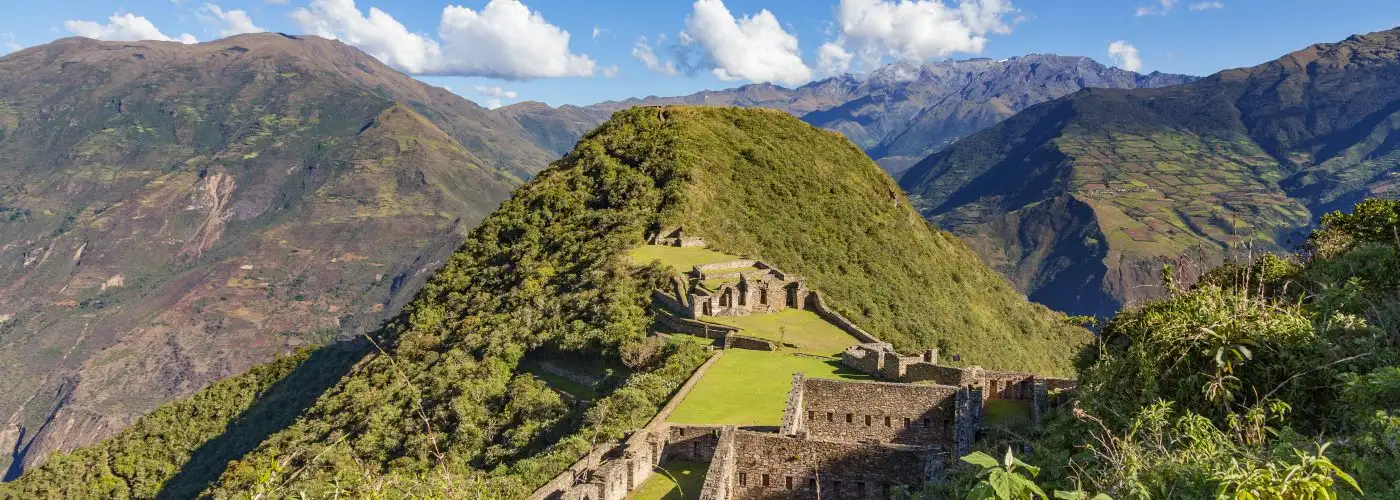
Machu Picchu Is Overrated, Go to Choquequirao Instead
Josh Roberts
Josh Roberts believes the best trips involve long hikes and muddy boots. His life goals haven't changed much since he was a kid: He still wants to be Indiana Jones when he grows up.
Follow him on Twitter ( @joshwhowrites ) and Instagram ( @joshwhowrites ), and visit his website ( joshrobertsbooks.com ) or Goodreads page to learn more about his forthcoming novel.
Josh joined SmarterTravel in 2001, and is an active member in both the Society of American Travel Writers (SATW) and the Society of Children's Book Writers and Illustrators (SCBWI).
In addition to SmarterTravel, he has written for USA Today, The Boston Globe, Yahoo! Travel, The Huffington Post, Airfarewatchdog, TripAdvisor, Jetsetter, ABC News, Oyster , and Business Insider . His travel photography can be seen in Britain and Ireland's Best Wild Places , published by Penguin UK.
The Handy Item I Always Pack: "A lacrosse ball. It's small, lightweight, and works wonders on loosening up tight muscles."
Ultimate Bucket List Experience: "Being the first to discover an ancient lost city. Failing that, visiting as many of the already-discovered ancient ruins as possible."
Travel Motto: "Not all those who wander are lost." -J.R.R. Tolkien
Aisle, Window, or Middle Seat: "Aisle."
Travel Smarter! Sign up for our free newsletter.
The first bus to Machu Picchu leaves Peru’s party-all-night tourist town, Aguas Calientes, at six in the morning. The line to be on it forms sometime after midnight, and by the time the sun pokes over the Andes, the fabled “Lost City of the Incas” looks less like one of the great wonders of the ancient world and more like a modern day Disney theme park.
Don’t get me wrong. It’s hardly Machu Picchu’s fault that you’d barely raise an eyebrow if someone emblazoned the words “Welcome to Incaland” on a sign above the ticket gate. On its own, the 15th century city is everything you hope it will be: a sprawling maze of terraces and stonework, a mountaintop citadel 8,000 feet above the Urubamba River Valley, an ancient marvel. From a distance, it looks just like the postcards.
But up close … ?
Elbow-to-elbow tourists. A relentless parade of buses. A five-star hotel and a dozen different Wi-Fi signals. It even has its own app. The disappointing truth is that while Machu Picchu is undoubtedly an awesome archaeological spectacle, it’s also everything you secretly fear it might be: crowded, noisy, underwhelming. A tourist trap.
The Other Machu Picchu
But maybe I’m biased. I was already of two minds about visiting Machu Picchu before I booked my trip to Peru. On the one hand, how can you go to Peru and not see Machu Picchu? On the other, is there anywhere in South America that’s more famous, more photographed, more Instagrammed? Part of me felt like I’d already experienced Machu Picchu before even setting foot in Peru.
I crave the kind of travel experiences that require trekking poles and a sturdy pair of hiking boots—which is why I rarely find myself among the selfie-stick-toting throngs of sightseers like the ones I saw at Machu Picchu. And it’s why the lure of the world’s most famous Inca city alone wasn’t enough to get me on the plane to South America.
A few years ago I heard about another Inca city on a mountaintop. Like Machu Picchu, it was rediscovered by American explorer Hiram Bingham on one of his early expeditions to South America. And at 10,000 feet, Choquequirao (“cho-kay-kee-rao”) is quite a bit higher than Machu Picchu—and a lot less accessible. Therein lay its appeal to me.
The traditional route to Choquequirao requires two days of hiking from the small village of Cachora, about four hours by car from Cusco. This is followed by another four to six days on foot at high altitude before returning to civilization via the Salkantay trek route. No cars, no hotels, no Wi-Fi. There aren’t any other options for getting to Choquequirao, either.
You finish the trek on foot or on a stretcher—that’s how my trip leader on the Choquequirao to Machu Picchu trek with G Adventures put it. He wasn’t joking, although the truly desperate could hitch a ride on the back of a pack horse.
My guide’s nickname was Rambo, and he didn’t come by it ironically. “The Choquequirao trek is three times harder than the Inca Trail to Machu Picchu,” he said at the outset. Then he reconsidered. “Maybe five times harder.”
He wasn’t joking about that, either.
View this post on Instagram The sun rises over the #incaruins of #choquequirao on the #choquequiraotrek with #gadv and #smartertravel in #peru #southamerica #suramerica #andes #mountains #hiking #trekking #sunrise A post shared by Josh Roberts (@jauntist) on Aug 4, 2016 at 7:25am PDT
Trekking to Choquequirao with G Adventures
With G Adventures , the Choquequirao to Machu Picchu trek spans about 100 miles over eight unforgiving days and seven long nights in the wilderness. You camp in tents and drink boiled water. You reach a lung-crushing elevation of nearly 14,000 feet, and in the South American winter (when I went) the days are hot and the nights are freezing. A thermal sleeping bag is your best friend. Sunscreen and DEET are your constant companions.
It’s not all hardship, though. The endless cascade of snowcapped peaks, distant rivers, and soaring condors keep you putting one step in front of another on the relentlessly uphill-downhill (never flat) trek.
And then on day three—Choquequirao. The Machu Picchu of a half century ago. No crowds. No roped off areas. Nothing but you and an ancient Inca city in the remote mountains of Peru, with no limits on where you can explore or how long you can spend doing it.
An Inca theme park, this is not.
https://www.instagram.com/p/BIsBiJCjitp/
To be fair, Choquequirao is smaller than Machu Picchu. It’s estimated that only about 40 percent of the site has been restored, and indeed when I crawled through the overgrown jungle separating some of Choquequirao’s restored areas I found evidence of Inca stonework that hadn’t yet been excavated. Maybe it’s just me, but I think that’s a selling point.
Choquequirao won’t be like this forever, though. In an effort to ease the tourist pressure on Machu Picchu, the Peruvian government recently announced plans to build a cable car to Choquequirao . Preliminary work is underway to rebuild an Inca road between Choquequirao and Machu Picchu that would allow hikers to trek directly from one site to the other on the same route the Incas once walked. More archaeological renovation of the city itself is planned, too.
“Five years ago, you might get one or two groups a month to Choquequirao,” Rambo says. “Now, one or two a day. Five years from now … ” He doesn’t have to finish the thought. The Choquequirao of the future is going to look an awful lot like the Machu Picchu of today, likely a lot sooner than later.
Opinions will vary as to whether that’s a good thing. I come down on the side of “see it now.” It’s a tough trek, rated the highest difficulty by G Adventures, but I think most people who exercise regularly could do it. Mind of over matter and all that—your body can handle it as long as you don’t let your brain talk you out of it.
And at the end of the trek, you still get to see Machu Picchu and compare the two sites for yourself. Machu Picchu may not be all it’s cracked up to be, but it still makes for a great photograph.
View this post on Instagram Mission accomplished. #machupicchu #peru #hiking #boots #hikingboots #trekking #southamerica #suramerica #incatrail #smartertravel A post shared by Josh Roberts (@jauntist) on Jul 27, 2016 at 5:25pm PDT
More from SmarterTravel:
- Patagonia and Torres del Paine: Hiking at the Edge of the World
- A Wild Kingdom in the Clouds: Inside Ecuador’s Mashpi Lodge
- Machu Picchu Travel: Everything You Need to Know
[viator_tour destination=”937″ type=”3-mod”]
Josh Roberts trekked from Choquequirao to Machu Picchu as a guest of G Adventures, who sponsored his trip. Follow him on Instagram and Facebook .
We hand-pick everything we recommend and select items through testing and reviews. Some products are sent to us free of charge with no incentive to offer a favorable review. We offer our unbiased opinions and do not accept compensation to review products. All items are in stock and prices are accurate at the time of publication. If you buy something through our links, we may earn a commission.
Top Fares From

Don't see a fare you like? View all flight deals from your city.
Today's top travel deals.
Brought to you by ShermansTravel
9-Nt Dublin, Cork, Killarney & Galway...
Railbookers

Luxe, 12-Night Spain, France, Monaco &...
Regent Seven Seas Cruises

Ohio: Daily Car Rentals from Cincinnati

Trending on SmarterTravel
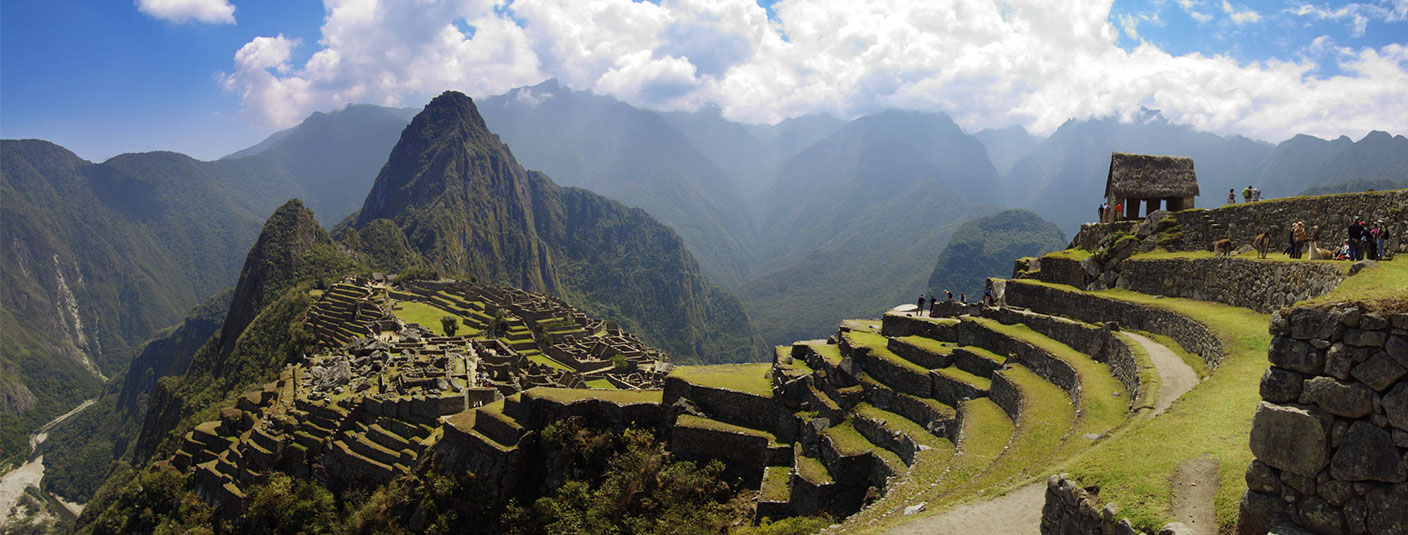
Machu Picchu
Machu Picchu is the Lost City of the Incas and inspires awe at first sight, especially if you journey there on the Inca Trail . Browse our destination guide below for essential travel details and top attractions to check out on your visit.
Only a few places in the world possess the kind of natural beauty and historic charisma that can capture the hearts and minds of visitors in an instant. Machu Picchu is one of them. Morning or afternoon, rain or shine, crowded or not - the sight of the stone temples and endless terraces set amid green-clad granite mountains never disappoints.
Forgotten after the fall of the Inca Empire and rediscovered 400 years later, Machu Picchu remains shrouded in mystery. Some questions may never be answered, but the former Inca city remains as irrefutable evidence of their highly advanced stonemasonry.
Whether by train or on your own two feet along the Inca Trail, getting to Machu Picchu is part of the adventure. Most visitors spend at least one night in Aguas Calientes, the small town at the base of the mountain from the Inca ruins. We recommend exploring the UNESCO Historic Sanctuary of Machu Picchu and New World Wonder with an expert guide, so you don’t overlook the brilliant engineering features and asserted significance built into the design of sacred temples.
Climate & Weather
Machu Picchu is at the intersection of the Andes and the Amazon, where the mild subtropical climate has warm days and cooler nights. Humidity is also higher than in Cusco and the Sacred Valley.
Dry Season and Rainy Season
Weather at Machu Picchu changes quickly and is unpredictable throughout the year. Similar to other high altitude destinations in Peru, the region has a dry and rainy season, but these conditions changes in the weather aren’t as clearly defined. The dry winter season for Machu Picchu is from April to October, and the wet summer season is from November to March. Remember, the northern and southern hemispheres experience opposite seasons.
Average Temperatures
Daytime: 68°F - 80°F (20°C - 27°C) Nighttime: 50°F - 64°F (10°C - 18°C)
Best Time to Visit
- The peak season for Machu Picchu is June, July, and August. These months coincide with the region’s dry season when sunny conditions are most probable and considered by many the best time to go to Machu Picchu. Hotels, entry tickets, and other services fill up quickly, so make your reservations well in advance.
- The low season for Machu Picchu is from December to February during the rainy season. There are fewer tourists and less crowding around attractions within the citadel. Still, the tradeoff is a much higher probability for rain, so don’t forget your raingear.
Geography & Map
- Machu Picchu is located 50 miles (80 kilometers) northwest of Cusco in the Urubamba Province of Peru, where the eastern slopes of the Andes meet the Amazon Rainforest. The Inca built their city on a high mountain ridge overlooking the lush cloud forest surroundings. Far below, Urubamba River flows along the valley floor, past Aguas Calientes.
- Elevation 7,970 ft (2,430 m)
Construction for Machu Picchu began at the height of the Inca Empire around 1450 AD. Most scholars agree the mountaintop city was the royal estate of Pachacutec, the powerful 9th king. Others speculate it was a sacred center where the great political, religious, and economic minds of the Inca Empire gathered.
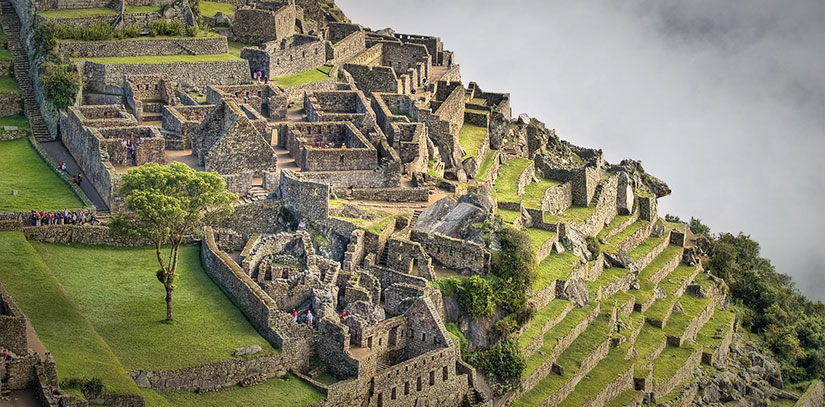
Before the construction of Machu Picchu began, they surveyed the mountaintop site. They built canals to carry freshwater to different sectors of the city. Incredibly, the Inca didn’t use steel or iron tools, nor the wheel, to make the temples, living quarters, and stone steps. Instead, they utilized simple materials such as stone, wood, and bronze. Rows of terraces were also constructed along the mountainsides for support. Without them, Machu Picchu would have tumbled down, unable to withstand centuries existing in a region prone to earthquakes and annual heavy rain.
Less than one hundred years after the construction of Machu Picchu began, during the 1530s, the city was abandoned in the aftermath of the Spanish Conquest. Widespread knowledge of the city was lost to official memory over the centuries except for some locals.
In 1911, Yale history professor Hiram Bingham chanced upon Machu Picchu while looking for the legendary city of Vilcabamba where resistance rebel leader Manco Inca retreated to safety from Spanish troops. After years of silent existence, Machu Picchu had been rediscovered and was flung into the international spotlight.
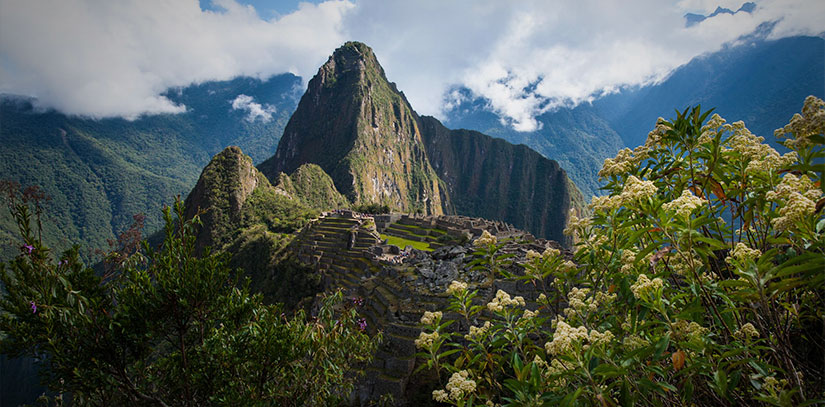
Today, Machu Picchu is a UNESCO World Heritage Sanctuary and the most visited attraction in Peru. The Ministry of Foreign Trade and Tourism counted 800,200 visitors to Machu Picchu in 2007, when the attraction was named one of the New Seven Wonders of the World, and since then that number has nearly doubled. In 2019, the famous Inca ruins were visited by 1,585,300 people from around the world.
Things to Do
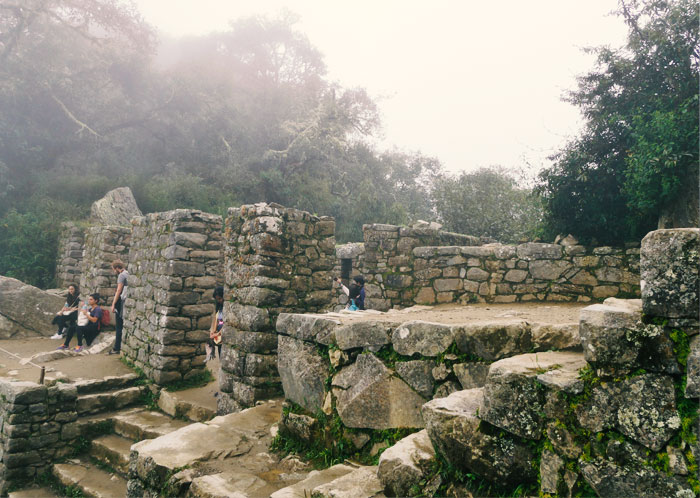
Passengers can board the train in Cusco at the Poroy Station (a 20-minute taxi ride from the city plaza) or in the Sacred Valley at the train station in Ollantaytambo and then continue along the tracks to Aguas Calientes. Upon arrival at Machu Picchu Station, the final leg of your journey is a 20-minute shuttle bus (ticket required) or uphill walk to the main entrance of Machu Picchu.
Routes & Travel Times:
- The train from Cusco to Machu Picchu is 4 hours
- The train from Ollantaytambo to Machu Picchu is 2 hours
- The train from Urubamba to Machu Picchu is 3 hours (*limited weekly departures)
Train Luggage Restrictions:
You have to travel light when you take the train to Machu Picchu because storage room onboard is limited. Each passenger is only allowed one carry-on luggage that weighs no more than 11 lbs (5kg). Many hotels in Cusco and the Sacred Valley offer free luggage storage, where you can leave a separate bag filled with belongings you won’t need for this leg of your trip.
Aguas Calientes to Machu Picchu
Aguas Calientes town is located 5.5 mi (9 km) from the Machu Picchu archeological site and 1,310 ft (400 m) of altitude lower. From the bus stop located only 3 to 5 minutes walking from the train station in Aguas Calientes, buses ferry passengers between the town and the ruins, using a zigzagging switchback road to go up and down the steep mountainside. Most tours to Machu Picchu include the bus tickets in the total price of the package. Tickets for the bus can also be purchased in Cusco or in Aguas Calientes in front of the bus stop.
The first buses depart at 5:30 am, arriving at the entrance of Machu Picchu just before the gates open at 6:00 am. Lines are usually the longest in the morning between 5:30 am and 6:15 am and when the mid-morning trains arrive from Cusco and the Sacred Valley between 9:00 am to 10:00 am.
Trekking to Machu Picchu
Adventurous travelers should trek to Machu Picchu! Trekking packages are organized so you trek to the famous archaeological site and return by train on the return leg of your journey.
The iconic 4-day Inca Trail to Machu Picchu is the most popular trek in South America. The journey takes you through high Andean passes, past lesser-known Inca sites, and culminates with a memorable entrance to Machu Picchu through the Sun Gate. There’s also the 2-day Inca Trail if you are on a tight schedule or prefer a less demanding walk.
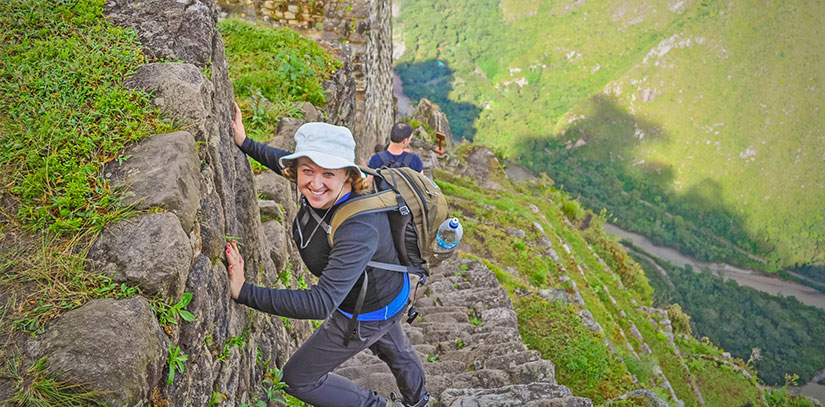
To hike the Inca Trail, you must reserve a permit in advance. There are wonderful alternative treks to Machu Picchu that don’t require a permit if Inca Trail permits are already sold out.
The 5-day Salkantay Trek is an excellent alternative trek to Machu Picchu for travelers who appreciate nature. This Andean trail passes by the imposing snow-capped Salkantay mountain, for which the trek is named, and crosses highland pampas before dropping down into a river valley cloud forest and then onto Machu Picchu. Read more about the Salkantay Trek.
The 4-day Lares Trek is another alternative recommended for trekkers whose interest lies in cultural immersion. Follow a route through the Lares Valley, passing remote villages with rich Andean traditions, beautiful mountain scenery, and lesser-known Inca ruins before touring Machu Picchu on the final day. Read more about the Lares Trek.
Visitor Guidelines
Machu Picchu Tickets
Tickets to Machu Picchu are limited and must be purchased in advance. There are general entry tickets and ones that include the hikes for Huayna Picchu (only 400 daily available) or Machu Picchu Mountain (only 400 daily available). Demand for Huayna Picchu and Machu Picchu Mountain is especially high during the peak June, July, and August dates. Advanced planning - sometimes 4 months in advance - is a must. Reserve your spot at the time you book your Machu Picchu tickets.
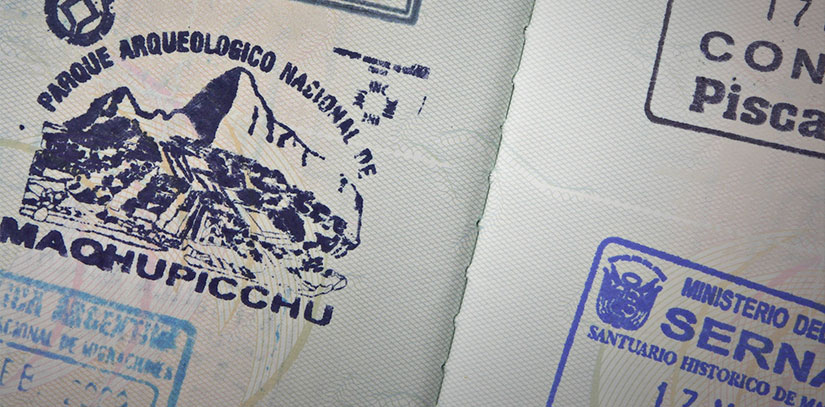
Tickets are not sold at the main entrance. If you’ve waited until the last minute, your final opportunity is at the National Cultural Institute (INC) office on the main plaza in Aguas Calientes.
Time in Machu Picchu
The time designated for you to enter Machu Picchu is selected when you buy your tickets in advance. For whichever assigned time indicated on your ticket, you have the full hour to enter the archaeological site. We suggest you arrive at the bus stop in Aguas Calientes at least one hour before your entrance time at the Machu Picchu ruins.
- An entry ticket to Machu Picchu is valid for 4 hours.
- An entry with a Huayna Picchu ticket gives you 6 hours to go on a Machu Picchu tour and do the hike.
- An entry with Machu Picchu Mountain ticket gives you 7 hours to take a guided tour and do the hike. This hike is longer than Huayna Picchu hence why you have more time in Machu Picchu.
Walking circuits around Machu Picchu help control foot traffic. Routes 1 and 2 (indicated in green and red on the map) pass similar attractions but explore different sections of the agricultural zone near the main entrance gate. Route 3 in blue is an alternative walking route so visitors with hiking permits can do Huayna Picchu or Machu Picchu Mountain.
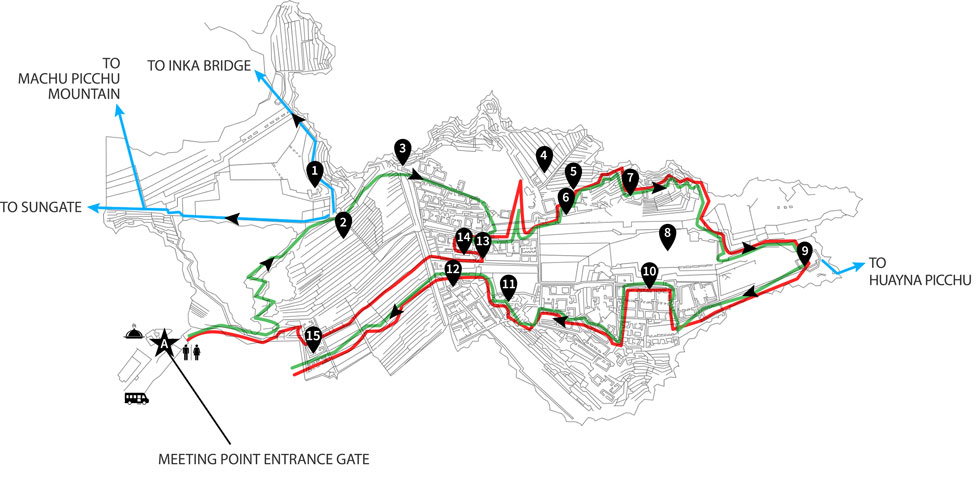
Points of interest:
- Guardhouse.
- Agricultural Zone.
- West Agricultural Zone.
- Temple Zone.
- Temple of The Three Windows.
- Astronomical Observatory.
- Main Square.
- Sacred Rock.
- Group of the Three Doorways.
- Royal Enclosures.
- Temple of The Condor.
Walking Circuits:
- Alternative Routes (hikes)
Options for Machu Picchu hotels range from 5-star luxury resorts to budget dorms and everything in between. Machu Picchu Sanctuary Lodge is the only hotel up on the mountain next to the main entrance of the archaeological complex. All other accommodations are in Aguas Calientes and walking distance from the train station.
It’s possible to make a whirlwind Machu Picchu trip in one day. Still, we recommend enjoying this highlight of your trip at a slower pace, if possible. Staying a night or two in Aguas Calientes spaces out the legs of transport to and from Machu Picchu and helps you stay rested for an active day of touring. The following are our Top Pick Hotels for travel to Machu Picchu.
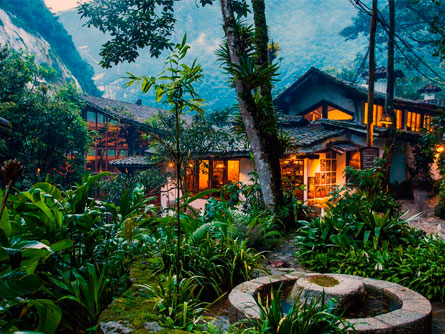
Inkaterra Machu Picchu Pueblo Hotel
Kilometer 110 Via Ferrea, Aguas Calientes, Machu Picchu
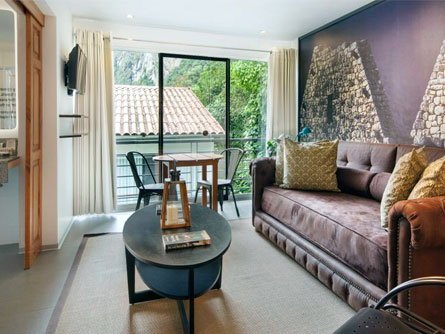
Av. Pachacutec 109, Aguas Calientes, Machu Picchu
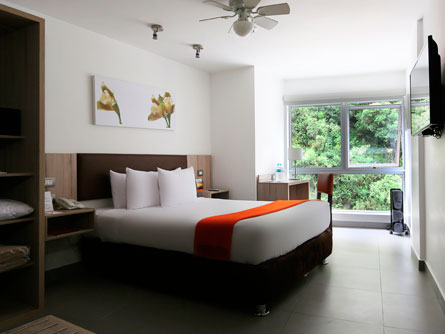

Casa Andina Standard Machu Picchu
Prolongacion Imperio de Los Incas E - 34, Aguas Calientes, Machu Picchu
Waman Hotel
Calle Wiracocha 202, Aguas Calientes, Machu Picchu
See all Machu Picchu Hotels
Restaurants
Eating options outside the entrance to Machu Picchu are convenient, though limited. You can take a pre-made box lunch with you to Machu Picchu (available options depend on your itinerary), eat a buffet lunch at Belmond Sanctuary Lodge, or grab a quick bite at the Machu Picchu Snack Bar.
Down the hill in Aguas Calientes the restaurant selection is far more varied. Enjoy a casual sitdown meal in Machu Picchu’s gateway town at one of the following restaurants:
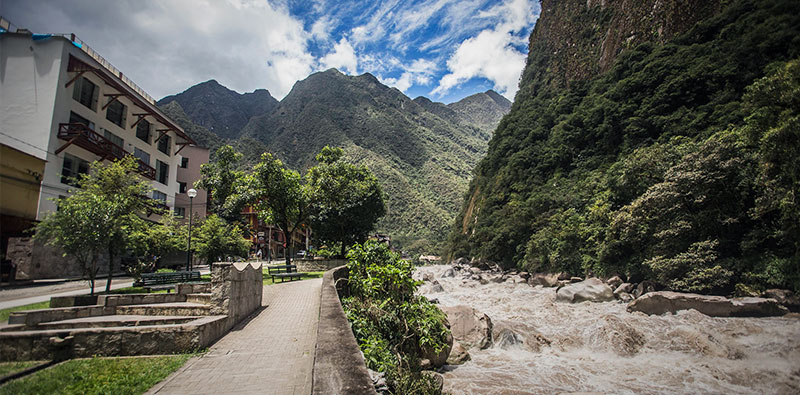
Chullpi Machu Picchu
Chullpi serves mouth-watering Peruvian fusion dishes, including trout ceviche, perfectly grilled chicken breast, and delicious salads, and tasty appetizers. If you’ve got room for dessert, go for the Tres Leches cake. 140 Av. Imperio de Los Incas, Aguas Calientes| website
Incontri del Pueblo Viejo
Incontri del Pueblo Viejo will satisfy your craving for carbs with homemade pasta and wood-fired pizzas featuring fresh toppings and real mozzarella. Wash it all down with a craft beer or an Italian or South American wine. Av. Pachacutec, block 6 (no number), Aguas Calientes| website
Indio Feliz Restaurant Bistro
Indio Feliz is a perennial favorite among travelers for its menu of Peruvian classics with a French twist. Try the river trout or the grilled chicken, each prepared with seasonal Andean ingredients. Check out the quirky Captain’s Bar before or after dinner. Calle Lloque Yupanqui 103, Aguas Calientes | website
The Tree House Restaurant
The Tree House is a few steps above the rest, in both the culinary and the literal sense. Located up a steep alleyway on the edge of town, this excellent restaurant serves a menu of Peruvian fusion cuisine shaped by Andean, Italian, Asian, and Latin American influences. Try the mushroom and goat cheese ravioli, pork ribs in sweet elderberry sauce, or alpaca tenderloin topped with blue cheese. Calle Huanacaure 105, Aguas Calientes | website
Toto’s House
Toto's House is ideal for large groups, serving an all-you-can-eat buffet as well as an extensive a la carte menu. A convenient location close to the train station, views over the river, and live music in the evenings round out Toto’s offer. Av. Imperio de Los Incas 600, Aguas Calientes | website
Tour Packages

Machu Picchu, Cusco, Sacred Valley 4 Days / from $989
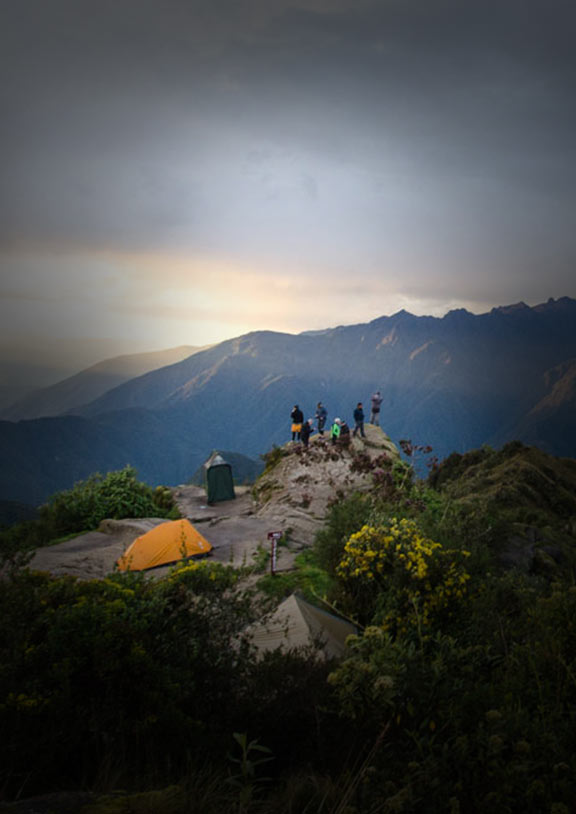
My 4 Hiking Options at Machu Picchu
Decide what Machu Picchu hiking option is the best for you. Take the Sun Gate or Inca Bridge trails. Other options are the climbs up Huayna Picchu or Machu Picchu Mountain.
Read more »
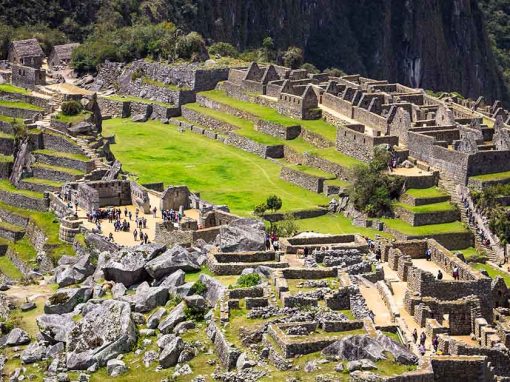
20 Machu Picchu Facts to Know Before Your Trip!
Have a trip to Peru coming up? Well, it’s time to brush up on your Machu Picchu facts! Machu Picchu

Book With Confidence
We're flexible! Postpone your tour with zero cost up to 30 days prior to departure.
By submitting this form, you agree to receive recurring customer care text messages from Peru for Less at the number used when signing up. Msg frequency varies. Msg and data rates may apply. View Terms & Privacy .
The following preferences are optional , but will help enhance your trip's customization.
Are you interested in visiting the best restaurants in Latin America?
TIP: Tell us the destinations you have in mind.
Galapagos Tours
Amazon Rainforest
Galapagos Islands
Sacred Valley
Lake Titicaca
5000+ Testimonials
+1 817 230 4971
Personalized Service
Handpicked hotels.
Are you sure you want to close the session?
La cuenta ya se encuentra activa
Or enter your e-mail:
Recover your offer
We will send you a 4-digit code shortly
Enter the 4-digit code and your new password
Enter your search here
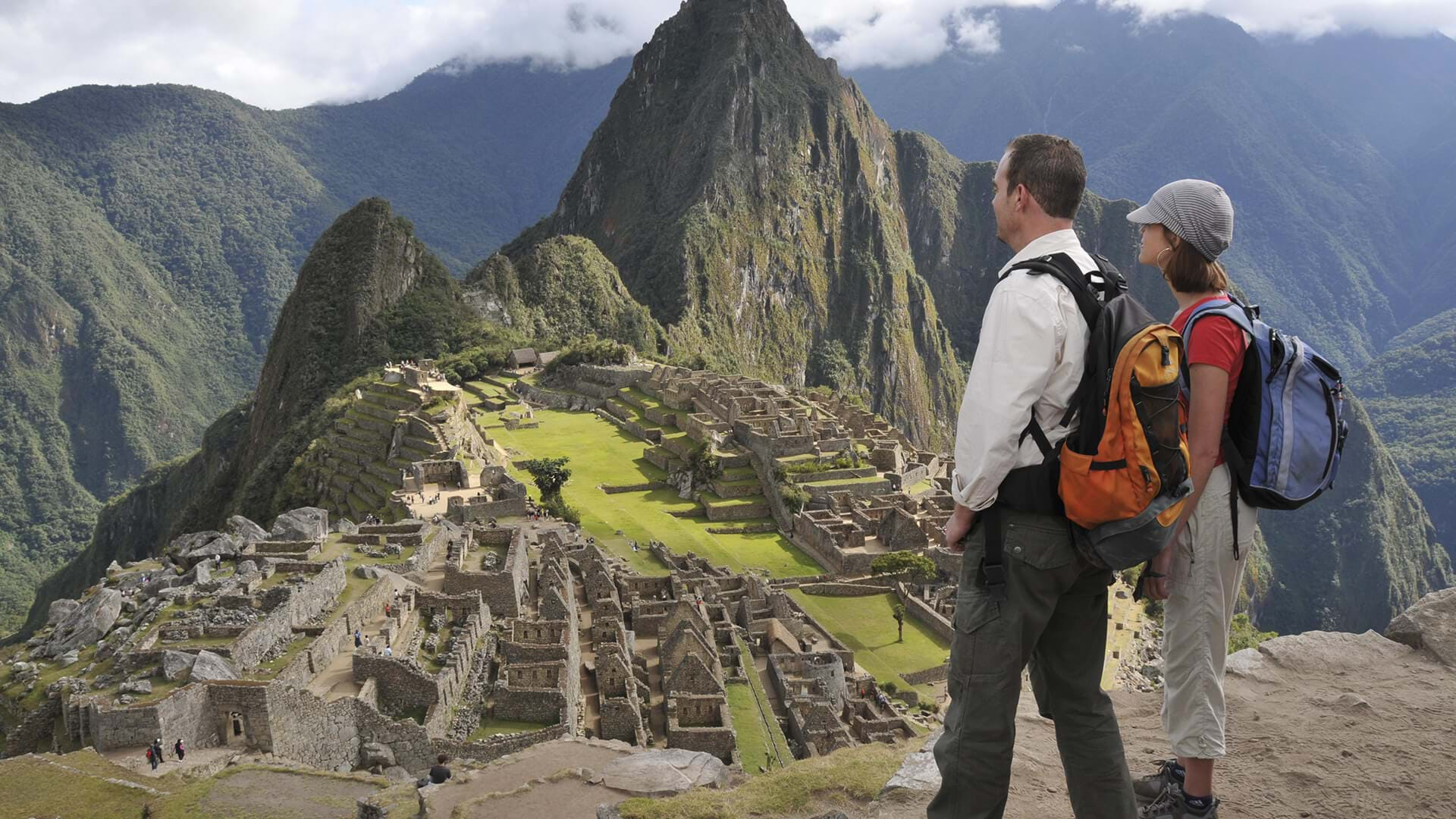
- Machu Picchu: complete guide to fully enjoy your trip
Take this recommendations so that you have an unforgettable experience.
Machupicchu, Cusco Credit: Eduardo Cayo / PromPerú
peru.travel
Reaching the most important tourist destination in Peru is not an easy task. Its special geographical location, added to the large number of people it receives daily, require some planning, and also, a a series of recommendations so that the experience is totally pleasant, without going over for any kind of setbacks.
The reason: this destination presents a wide variety of offers and packages that include all kinds of routes, accommodation and timetables, so a precise search is essential in order to choose the best option. To do this, we invite you to take a look this guide with useful tips so that you can enjoy this archaeological sanctuary to its fullest.
When to visit?
Many tourists who arrive in Machu Picchu usually coincide with sudden rains and a cloudy climate that sometimes prevents them from enjoying the wonderful view that the valley presents. To avoid this happening to you, the ideal time to visit the Inca citadel is between April and October, given that during these months the Cusco region goes through a dry season full of sunny days with temperatures ranging from 20° C during the day and 10° C at night.
However, if you go between November and March, it doesn’t mean that you’ll have a negative experience. During these months you could take advantage of a smaller presence of visitors and also enjoy a great green landscape often accompanied by a shimmering rainbow.
How to get there?
There are two ways to get to Machu Picchu. The fastest and most comfortable is by train with an approximate travel time of three hours. The trains depart every morning from Ollantaytambo and arrives in Aguas Calientes (closest town to the citadel), offering all kinds of services and amenities. If you wish to acclimatize before leaving, Aguas Calientes has multiple lodgings and a craft market for those who choose to take a day of rest. Otherwise, there are minivans that would take you to Machu Picchu if you prefer to continue.
Another alternative is going on foot along the road. Many tourists reserve this route in advance for everything it represents. If you are a lover of trekking and adventure, this experience will undoubtedly leave you ecstatic. It’s about a three to five-day excursion that will demand your maximum effort but it will be worth it because of the beautiful landscapes you will enjoy.
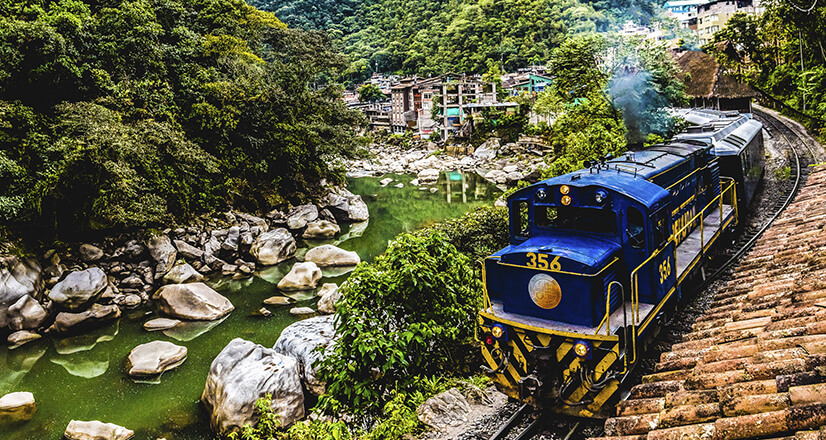
The fastest and most comfortable way to get to Machu Picchu is by train, with an approximate travel time of three hours. Credit: Shakedown Team / PromPerú.
How to hire a tour guide?
Due to the extension of Machu Picchu and in order to safeguard its integrity for visitors, it is mandatory to hire the service of a tour guide. This person not only will provide you with information you may did not know about the history of the Incas and the enigmatic origin of the citadel, but will assist you under any unforeseen event that may occur.
What to include in your backpack?
To enjoy a walk through the sanctuary, you need to take your passport or identity card with you and pack some comfortable items such as lightweight trekking shoes, a raincoat (in case of rain), sunscreen, a camera, repellent and a bottle of water that will help you cool down during and after the tour.
Be a responsible tourist
Finally, the most important recommendation for all visitors is to take care and preserve this complex. When visiting this sacred and historical place, try to comply with all the disposals and security measures without violating the warnings and prohibitions. Visitors must be aware of the cultural value that Machu Picchu represents so that future generations can enjoy and learn from its history.
Sources: El País / La Nación / Peru.com / El Mundo Ok / Boleto Machu Picchu / Guia de viajes
Follow us on social media Facebook | Instagram | Twitter | TikTok | YouTube

Find out more
6 places you can visit before arriving to Machu Picchu
Related articles
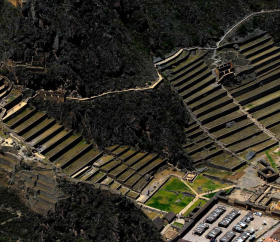
Ollantaytambo: an architectural jewel on the way to Machu Picchu
Discover this Inca fortress that impresses with its perfection.
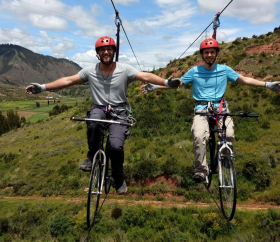
What adventure sports can you practice in Cusco?
Live the most extreme experiences in the impressive Sacred Valley.
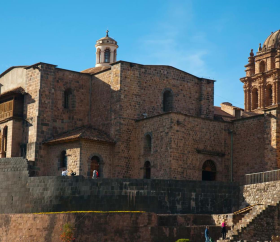
5 museums in Cusco that you should visit
Plan your trip to Cusco and start a cultural tour that will surprise you.
Friday, April 12, 2024 10:52 am (Paris)
- International
Machu Picchu protesters block tourist train tracks over privatizing ticket sales
Local operators are fighting the 'systematic privatization' of the historic site, but the culture ministry claim this move is necessary to control visitor numbers.
Le Monde with AFP
Time to 1 min.
- Share on Twitter
- Share on Messenger
- Share on Facebook
- Share by email
- Share on Linkedin

Visitors to Peru's iconic Machu Picchu site were met on Thursday, January 25, by protesters angry with the government for privatizing ticket sales at the Inca citadel. Launching what they called an "indefinite strike," tour operators and residents closed shops and blocked the tracks of a tourist train, compelling those on board to don rain jackets and walk the remaining three kilometers to the entrance.
The demonstrators banged on drums, waved flags and demanded the minister of culture resign. "We are against the systematic privatization of Machu Picchu. The people are not in agreement; this (ticketing) company was contracted illegally," community representative Darwin Baca told Agence France-Presse (AFP).
A local collective claims that the company granted the contract for ticket sales, Joinnus, will make as much as $3.2 million per year in commissions from the new system, which started on Saturday. Rail operator Ferrocarril Transandino announced it would suspend service on Friday between Ollantaytambo and Machu Picchu due to the clashes between protesters and police. "We adopted this measure to safeguard passengers and workers of the railway and after learning of the call for new protest actions by social organizations," the company said in a statement.
Ana Pena, an advisor to the Ministry of Culture, said the ticketing system was about preservation and controlling visitor flow at the popular historic site. "There is no privatization. We have to ensure absolute control of all the people who enter our citadel," she said. "There is a risk that Machu Picchu will be removed from the UNESCO World Heritage list" given that "excess visitors" can lead to deterioration, she said. Last September, Peru temporarily closed three sectors of Machu Picchu due to the impact of the heavy volume of visitors at the site.
Sitting northwest of the city of Cusco, Machu Picchu was built in the 15 th century at an altitude of 2,500 meters on orders from the Inca ruler Pachacutec. It is considered a marvel of architecture and engineering and was declared a UNESCO World Heritage site in 1983. The number of daily access tickets to the citadel increased to 4,500 per day starting this month, from an earlier maximum of 3,800.
Lecture du Monde en cours sur un autre appareil.
Vous pouvez lire Le Monde sur un seul appareil à la fois
Ce message s’affichera sur l’autre appareil.
Parce qu’une autre personne (ou vous) est en train de lire Le Monde avec ce compte sur un autre appareil.
Vous ne pouvez lire Le Monde que sur un seul appareil à la fois (ordinateur, téléphone ou tablette).
Comment ne plus voir ce message ?
En cliquant sur « Continuer à lire ici » et en vous assurant que vous êtes la seule personne à consulter Le Monde avec ce compte.
Que se passera-t-il si vous continuez à lire ici ?
Ce message s’affichera sur l’autre appareil. Ce dernier restera connecté avec ce compte.
Y a-t-il d’autres limites ?
Non. Vous pouvez vous connecter avec votre compte sur autant d’appareils que vous le souhaitez, mais en les utilisant à des moments différents.
Vous ignorez qui est l’autre personne ?
Nous vous conseillons de modifier votre mot de passe .
Lecture restreinte
Votre abonnement n’autorise pas la lecture de cet article
Pour plus d’informations, merci de contacter notre service commercial.
Protect Your Trip »
Machu picchu tours: how to get there and tips for visiting.
Here is everything you need to know to plan a trip to Machu Picchu.
How to Get to Machu Picchu

Getty Images
A hike around Machu Picchu is a must-do if you're visiting Cusco, Peru.
Note: Some of the below destinations may be affected by the civil unrest in Peru. Check with the U.S. Department of State before traveling.
Machu Picchu is thought to be one of the largest and most impressive Incan cities of its time. Today a UNESCO World Heritage Site with expansive ruins open to visitors, it sits high on a peak in the Peruvian Andes and is accessed via train or on foot. Here are some tips to help you navigate a visit to this incredible archeological site.
What is Machu Picchu? Machu Picchu is a 15th-century Incan city that was abandoned by the Incas after the Spanish conquest. The ruins feature about 200 structures that were used for religious, agricultural, astronomical and ceremonial purposes, though exactly how remains a mystery. It's believed that between 300 and 1,000 people inhabited the city and the area was devoted to the worship of the sun god.
Where is Machu Picchu? Machu Picchu is located in the Peruvian Andes within a tropical mountain forest at nearly 8,000 feet above sea level. Cusco , the nearest major city, is less than 50 miles southeast of Machu Picchu.
When was Machu Picchu built? Historians believe that Machu Picchu was built in the 15th century.
How do you get to Machu Picchu? Machu Picchu can be reached a variety of ways, including hiking the Inca Trail with a tour company, by train or by bus.
When is the best time to visit Machu Picchu? The site is located in the Amazon rainforest in Peru, where the rainy season runs from November to March. To avoid rain, travelers may want to visit during its dry season from April to October. Travelers say that June through August tends to be the busiest, so opting for shoulder months like May or October may help avoid crowds.
Know Before You Go
- What: Machu Picchu tours
- When: Machu Picchu is accessible daily with entrances from 6 a.m. to noon or noon to 5:30 p.m. During the month of February, the Inca Trail is closed for maintenance and is inaccessible to visitors.
- Cost: Entrance tickets cost approximately 152 Peruvian soles (about $45) for adults; 77 soles (around $23) for students.
- Must-know tip: To tour Machu Picchu, you must purchase your ticket online in advance and print it out as no tickets are sold at the site. Experts and fellow travelers recommend purchasing your ticket several months in advance as there only 2,500 visitors allowed per day. If you choose to visit with an organized tour company, the company will take care of reserving and purchasing the ticket for you.
- Website: https://www.machupicchu.gob.pe/inicio
When visiting Machu Picchu, you will be given a specific time you can enter the site. Key attractions include the Temple of the Sun, the Room of the Three Windows, the water irrigation system and the Royal Mausoleum. There is an additional fee to visit the mountains of Machu Picchu and Huayna Picchu, which surround the old city, should you want to hike trails there. After you purchase your ticket – either to Machu Picchu or the site with one of the mountains – be sure to print your ticket and bring it with you along with identification, such as a passport.
Restrooms are located outside the entrance and cost about 2 soles (around 60 cents) to use; there are no restrooms within Machu Picchu. There's no visitor center, but Peru's Ministry of Culture does have an office in Aguas Calientes, a town that acts as the gateway to Machu Picchu. There are also a variety of restaurants in Aguas Calienties to refuel after your trip. Be aware, you also may not be allowed to bring single-use plastics (like sandwich bags) or large bags into the site. If you do bring a large bag, there is a bag storage facility near the site's entrance where you can leave your bag for a small fee as you explore the site.
Machu Picchu is located less than 50 miles northwest of Cusco, a Peruvian city which is also a UNESCO World Heritage Site. Cusco can make a great base for your visit to Machu Picchu as many organized tours to the site begin here.
Since Machu Picchu and Cusco sit at high elevations, almost 8,000 feet above sea level, travelers should prepare for altitude sickness. Talk to your doctor before your trip to make sure your body can handle the altitude change. When you arrive, help your body adjust by getting plenty of rest for the first few days, avoiding alcoholic beverages and drinking lots of water to remain hydrated. You should also plan to wear insect repellent and plenty of sunscreen for the trek. Travelers also recommend dressing in layers and wearing pants and long sleeves, even if the weather is warm, as the mosquitos are known to be relentless.
Tour Options
Though you can opt to visit Machu Picchu (and make the necessary travel arrangements) by yourself, a guided tour can help streamline the process. Multiple tour operators offer daytrips to Machu Picchu. The majority of these tours originate in Cusco and leave early in the morning (at or before 5 a.m.). You'll be taken via bus to the town of Ollantaytambo, where groups board trains to Aguas Calientes. From Aguas Calientes, groups board a bus to Machu Picchu. Travelers generally spend approximately two hours at the site before they begin the trip back to Cusco. Exact tour prices vary, though you can expect to spend approximately $300 per person (including train tickets, bus fare and a guided tour of the site). Travelers generally enjoy the tours, extolling the knowledgeable guides, and appreciate the ease by which they could see Machu Picchu. Others caution selecting your tour company carefully as experiences can vary wildly from company to company.
Travelers can also opt to hike from Aguas Calientes to Machu Picchu on their own via the Carretera Hiram Bingham. The approximately 4-mile journey is a steep climb and can be completed in around 90 minutes. Though an option, most travelers say the walk is long, difficult and lacking in scenery.
Tourists who have ample time, or have a true adventure streak, can hike the Inca Trail to Machu Picchu. The approximately 25-mile trail takes about four days to hike and ends at Machu Picchu. To hike the Inca Trail, you must go with a tour company or hire a guide, as it is no longer permitted to hike the trail on your own. Keep in mind that the trail closes each February for maintenance. Tours can last as little as two days (for an abbreviated journey along the trail) or more than a week to experience additional Peruvian sites.
There are a variety of other attractions and ancient sites nearby Machu Picchu that you may want to add to your itinerary. Titicaca Lake, located at more than 12,000 feet above sea level, is the largest lake by volume in South America. The town of Cusco also has much to see, including cathedrals , temples and a plaza used in Incan times , along with many archeological sites. Take advantage of the Cusco Tourist Ticket (also known as Boleto Turistico del Cusco), which grants access to many of Cusco's attractions for one fee.
Getting There
You can reach Machu Picchu by foot, train or bus, though if arriving by train, your ride will end in Aguas Calientes and you will need to ride a bus or hike approximately 4 miles to access the site. You can take a train from one of several stations near Cusco to the city of Aguas Calientes and then ride a bus to Machu Picchu. (Note: Since these train stations are outside Cusco city proper, you'll need to take a bus to get to them). The train ride via Peru Rail takes about four hours and you can choose from a variety of train types, each with a different price point to accommodate any travel budget. Tickets for Peru Rail are available at PeruRail.com.
You can buy bus tickets from Aguas Calientes to Machu Picchu in advance in Cusco at the Consettur offices, which helps you avoid lines at the actual bus stop. Buses depart from Aguas Calientes approximately every 15 minutes beginning at 5:30 a.m. daily until 3:30 p.m. Visitors recommend getting in line for the bus several hours before your scheduled entrance time at Machu Picchu as lines can be extremely long. Some travelers report getting in line three hours before their scheduled entrance time. You'll also likely encounter lines to take the bus from Machu Picchu back to Aguas Calientes.
Additional tour options:
- CuscoPeru : Full-Day Private Machu Picchu Guided Tour from Cusco. View & Book Tickets »
- Viajes Pacifico : Machu Picchu Day Trip. View & Book Tickets »
- Viajes Peru : Day Tour to Machu Picchu The Inca City. View & Book Tickets »
- Machupicchu Latin America : 2-Day Tour: Sacred Valley and Machu Picchu by Train. View & Book Tickets »
- Inkayni Peru Tours : Full day. View & Book Tickets »
Looking for more information on Machu Picchu? Check out the U.S. News Travel Cusco guide .
Tags: Tours , Travel , Vacations , Peru
World's Best Places To Visit
- # 1 South Island, New Zealand
- # 4 Bora Bora
If you make a purchase from our site, we may earn a commission. This does not affect the quality or independence of our editorial content.
You May Also Like
The best kauai boat tours.
Lyn Mettler April 11, 2024

The Top-Rated NYC Food Tours
Ann Henson April 11, 2024

The Best Things to Do in Maine
Mariya Greeley and Nicola Wood April 10, 2024

The Best Pearl Harbor Tours
John Rodwan and Amanda Norcross April 9, 2024

The Best Pigeon Forge Dinner Shows
Korrin Bishop April 9, 2024

Flight Canceled or Delayed? What to Do
Amanda Norcross April 8, 2024

Carry-on Luggage Sizes by Airline

The Best Charleston Tours
John Rodwan April 4, 2024

The Best Napa Valley Wine Tours
Amanda Norcross April 4, 2024

The 10 Best Denver Tours
Lyn Mettler April 4, 2024

- Search Please fill out this field.
- Manage Your Subscription
- Give a Gift Subscription
- Sweepstakes
- Travel Tips
How to Experience the World’s Most Popular Tourist Destinations Like You’re the Only One There
:max_bytes(150000):strip_icc():format(webp)/Stacey-Leasca-2000-631fabdcfe624115bea0ce8e25fdec96.jpg)
With more than 2.1 million tags, Machu Picchu is the 13th most-Instagrammed place in the world, and with good reason. The mysterious architectural site situated in the Andean Mountains in Peru is breathtaking beyond belief.
The enormous structure, believed to be built in the 15th century, has stood the test of time thanks to the superior construction skills of the people of the Inca Empire. Each and every stone making up the gorgeous structure is so tightly fit together that you couldn’t even fit a blade of grass through the cracks.
Moreover, the grasslands and mountains surrounding Machu Picchu are such a magnificent green that photos posted to social media could never do it justice. So, while looking at photos of one of the new Seven Wonders of the World on social media is OK, visiting it in real life is even better. But, as all those tags show, visiting Machu Picchu is more popular than ever before. In fact, as many as 2,500 people come to see the ancient ruins every single day.
So how can you experience all that this beautiful place has to offer, without feeling like you’re just a part of the crowd? Here are a few tips to visiting Machu Picchu, or any popular tourist destination around the globe, like you’re the only one there.
Find off-peak hours.
Before visiting a popular tourist destination, it’s important to do a bit of homework about the site’s price, availability, what’s allowed, and hours of operation. Try to find out when peak days and times are so you can avoid those like the plague.
While Machu Picchu has done an excellent job at closely monitoring how many people are let into the site each day, it can still get a bit overwhelming mid-day. Like most popular attractions, the best time to arrive is either very early or close to closing time to avoid the larger lunch rush. Guests to Machu Picchu are let in each day between 6 a.m. and 4 p.m. and must leave by 5 p.m.
Get a guide.
For some more remote areas, or in places where you don’t speak the language, it could be a huge asset to hire a guide. On my excursion to Peru, Mountain Lodges of Peru helped my group learn about the past and current culture of the South American country all week long before ending on an incredibly high note at Machu Picchu.
There, our ever knowledgeable guide, Dalmiro Portillo , explained the rich history of the site and the speculative reasons why it’s even there, and informed us about each and every ceremonial area, including the Intihuatana Stone, which was an ancient clock used by the people living at Machu Picchu hundreds of years ago for religious ceremonies.
Dalmiro even knew when and where to go to beat all the crowds, which gets me to my third point.
Go off the beaten path.
Beyond knowing every little detail about one of Peru’s UNESCO World Heritage Sites , our guide was also very in-the-know about how to get off the beaten path and check out some of the sides of Machu Picchu other visitors never bother to see.
For example, behind Machu Picchu’s Agricultural Sector is a small trail leading to the Inca Bridge, which is believed to have been a secret entrance to Machu Picchu for the Inca army. The entrance to the short trail is marked by a warden’s hut. Before entering, you have to sign in with your passport number. The hike only takes about 20 minutes and is well worth the detour. On our short walk to the bridge we saw only a handful of other tourists compared to the hundreds swarming the main site by 10 a.m.
Additionally, Dalmiro knew that we needed to see Machu Picchu the right way, and that included hiking up Huayna Picchu, one of the two mountains flanking the historic site. Only 400 people are allowed to climb Huayna Picchu each day (same for its sister peak, Machu Picchu Mountain), meaning visitors must purchase a second ticket well in advance.
Those looking to climb the mountain can go in either the morning or afternoon group, each allowing a maximum of 200 people, ensuring this to be a much less crowded Machu Picchu experience. But buyer be warned: The hike is incredibly steep and difficult.
The hike rises just over 1,181 feet above Machu Picchu, the trail made up of hundreds of small steps, some parts no more than a few feet wide, but the destination is well worth the roughly two- to three-hour journey as the views from the top are unparalleled. At the peak make sure to not only snap a few pictures (to add to the 2.1 million already on Instagram), but to also put down your phone, take a few deep breaths, and realize just exactly where you are. You earned it.
And soaking it in may be the best advice of all when it comes to visiting popular destinations around the globe. Sure, others have been there before you, but your experience is uniquely your own. Make sure to stop, experience the moment, and enjoy it, before any fellow tourists can get in your way.
Machu Picchu Tours & Treks

As the mist lifts off the mountains and over the Inca ruins, Machu Picchu evokes an otherworldly feeling
It’s one of the world’s most incredible archaeological sites, with a breathtaking location to match. With all that Machu Picchu has to offer, it’s easy to understand why so many are drawn to the visitor heartland of Peru . The ultimate decision is how to get there. Choose a trek or take the train? You could hike through cloud forests along the classic Inca Trail, fulfill your Andes experience on the Quarry Trail or challenge yourself on the Choquequirao trek – it's up to you. We don’t need to tell you why the adventure is worth your while. Our local leaders will keep you safe, informed and inspired every step of the way.
Our Machu Picchu trips
Let's create an exclusive trip for your group.
Machu Picchu highlights
Which route is right for you.
With its spectacular natural scenery and profound cultural encounters, the Inca Trail is an international beacon for trekking. Attracting thousands of hikers each year, it's a challenging yet rewarding hike that stays with you for a lifetime. Although rated moderate, the relentless uphill (and downhill) hiking is tough - the fitter you are, the more you’ll enjoy it.
For an impressive hike off the beaten path, consider the Inca Quarry Trail. This lesser-known trek offers the same magical scenery of the Andes mountains, passing through local villages and visiting three smaller archaeological sites the other trails don’t. Another bonus is that the hike doesn’t require a permit – so once you book, you’re set.
Take your boots further with a challenging eight-day hike moving through high-altitude cloud forests, over mega mountain passes and along an ancient trail leading to the well-preserved Inca city ruins of Choquequirao. This trail might be secluded and not for the faint-hearted but it's also one adventure you'll never forget, and that's a promise.
Meet our team
Why choose us.
All our guides are certified local tour guides and trained in-house on Intrepid Safety Policies. Each trekking guide also receives exclusive Intrepid training, provided by mountain rescue experts in the field.
All our guides and trek leaders have been trained by medical specialists in handling altitude illness and are proficient in first aid. Our team carries oxygen cylinders on all treks for emergency use.
Our team members live and work in the Andean region, which means revenue from all our treks benefit the local economy.
We take care of the details, so you can focus more on enjoying the journey. Our tours include all meals, with essential camping equipment and the option to hire additional hiking equipment if needed.
We are proud to have the tick of approval from the Rainforest Alliance indicating that we meet and operate at the highest standards in environmental, social and economic sustainability.
We strive to use travel as a force for good. That’s why we choose to give back to the communities we visit, carbon offset all our trips and take our social and environmental responsibilities seriously. We’ve been officially certified as the world’s largest travel B Corp, which means when you choose Intrepid Travel, you can rest assured you’re traveling to improve the planet.
Machu Picchu tour reviews
Filter by rating
Inca Trail Express
Inca Trail Express from Lima
Articles of Machu Picchu
Machu Picchu or Chichen Itza? Which historical site should you visit?
What I wish I knew before hiking to Machu Picchu
An open thank you letter from blind athlete, Dan Berlin, to his local leader
Inca Trail permits for 2020 are about to go on sale. Here’s everything you need to know.
Behind the scenes on the hardest physical challenge of my life: the Inca Trail
Why trekking the Inca Trail was the best way to celebrate turning 50
10 things you’ll only know if you’ve travelled in Peru
What to see at Machu Picchu? A guide to Peru’s ancient ruins
Learn more about Machu Picchu
Similar destinations.
Thinking about a trip to Peru but need help comparing it with other ancient sites? Check out our blog:
Machu Picchu or Chichen Itza
Machu Picchu travel FAQs
Do i need a covid-19 vaccine to join an intrepid trip.
Trips from 1 January 2023 onwards
From 1 January 2023, Intrepid will no longer require travelers to provide proof of vaccination against COVID-19 (excluding all Polar trips and select adventure cruises).
However, we continue to strongly recommend that all Intrepid travelers and leaders get vaccinated to protect themselves and others.
Specific proof of testing or vaccination may still be required by your destination or airline. Please ensure you check travel and entry requirements carefully.
What is Machu Picchu?
Machu Picchu is a magnificent reminder of the power and ingenuity of the Inca civilization.
The ancient citadel, built in the 15th century, was abandoned only 100 years later, and many mysteries remain.
Listed by UNESCO as a World Heritage site in 1983 and announced as one of the Seven Wonders of the World in 2007, Machu Picchu makes a lasting impression.
Where is Machu Picchu?
Overlooking the Urubamba River, the site of Machu Picchu sits above the Sacred Valley – located in the Cusco region of Peru.
How can I get to Machu Picchu?
Many travellers fly into the capital of Cusco before taking the train or choosing a hiking tour. The stepping stone to Machu Picchu is Ollantaytambo, about 1.5 hours away from Cusco by bus.
From Ollantaytambo, the most common ways to get to Machu Picchu are:
- Hiking the Inca Trail (one way to Machu Picchu)
- Taking the equally scenic and rewarding Quarry Trail
- Trekking the challenging 8-day Choquequirao Trail
Can I still hike if I take the train?
So, you want to experience the Inca Trail but aren't quite up for the entire hike?
The one-day option takes you by train part of the way where you hop off and trek the trade highway of the ancient Inca empire.
You will arrive at the Sun Gate in the afternoon to take in the views of Machu Picchu.
Is hiking the only way to get to Machu Picchu?
On all of our trips that visit Machu Picchu, you can choose the rail journey instead of the hike – simply specify while booking that you’d prefer the train option. There's no extra cost for this, though please note fees may apply if you decide to change to the train option after your Inca Trail permit has already been purchased.
Learn more about taking the train to Machu Picchu
When is the best time to visit Machu Picchu?
You can visit Machu Picchu all year round. The most popular time, and therefore the most crowded, is in June and July.
Low cloud cover during the dry season from April to October also means cold nights on hiking trails, so you'll need thermals for a good night’s sleep.
The wet season is from November to March. Temperatures rise and the region receives heavy rainfall, so waterproofs are essential if you're hiking. If you don't mind a bit of rain, the plus side is that crowds are smaller. If you want to hike the Inca Trail, note that it closes every year in February for maintenance.
Can you get to Machu Picchu in a day?
Yes, you can. Starting with an early rise in the morning, take a 1.5-hour bus ride to Ollantaytambo, then a 2.5-hour train to Aguas Calientes, followed by a 30-minute bus to Machu Picchu.
You will have a couple of hours to visit Machu Picchu and then return to Cusco the same way.
None of our trips visit Machu Picchu this way, as we believe it doesn’t allow enough time to explore (and really enjoy) the site and the Sacred Valley area.
How high is Machu Picchu?
Machu Picchu is found deep in the cloud forest at 2440 m (7972 ft) above sea level, sitting at 1000 m (3280 ft) lower than Cusco.
What does this mean for you? In terms of altitude, you're unlikely to experience any altitude issues at Machu Picchu itself.
But be aware, trekking to Machu Picchu involves walking up and down several steep stairs, ramps and terraces at various altitudes, which can be strenuous.
Will the altitude affect me?
Most people start to feel the effects of altitude at over 2000 m (6561 ft) regardless of age, gender or fitness level. While our leaders have basic first aid training and are aware of the closest medical facilities, it is very important that you make yourself aware of the causes and effects of traveling at altitude. Monitor your health and seek assistance accordingly.
It is essential to take it easy, drink plenty of water and speak to your group leader immediately if you feel unwell.
We recommend seeing your doctor if you have health concerns before the trip, especially if you have a pre-existing medical condition or are taking any medication.
Do I need a permit to hike to Machu Picchu?
Everyone hiking to Machu Picchu via the iconic Inca Trail or the shorter Inca Trail Express requires a permit. You don't need a permit to trek via the Quarry or Choquequirao trails.
If you do the Inca Trail with Intrepid, our adventure consultants secure your permit for you so you can focus on getting excited – just make sure you have your passport details handy at the time of booking.
Permits are available on a first-come, first-served basis, so booking well in advance is critical.
We endeavor to purchase your permit within two working days of receiving all necessary information.
What should I pack for Machu Picchu?
For a day trip exploring Machu Picchu, we recommended taking a small backpack with the essentials: sunscreen, hat, water bottle (filled before departing), a few snacks and mosquito repellent. It helps to wear breathable pants, a long shirt and a waterproof jacket – since the UV index is higher in the Andes and the site is prone to rainfall.
If you plan to trek before visiting Machu Picchu, read our detailed packing instructions in your Essential Trip Information.
What is Wayna Picchu?
Wayna Picchu (also known also as Huayna Pichu or Wayna Pikchu) means ‘young peak’ in Quechua – although the mountain appears anything but young, towering behind Machu Picchu.
Known as the ‘stairs of death’, the hair-raising climb takes about three hours to return. More recently, a cap of 400 people a day has been introduced on the number of visitors allowed to climb.
Can I climb Wayna Picchu with Intrepid Travel?
We have performed risk assessments on all our optional activities, and unfortunately, we don't consider climbing Wayna Picchu a safe activity at this stage.
Reaching Wayna Picchu involves climbing steep, narrow and exposed sets of stairs, and we just can't guarantee your safety.
Our leaders are specifically prohibited from assisting you in visiting Wayna Picchu.
What are the toilet facilities like at Machu Picchu?
There are public toilets located at the main entrance of Machu Picchu and none after entering the site – so make sure you time your stop before heading off to explore.
Take some coins with you as there is a small fee to use the toilet facilities.
What does the Rainforest Alliance tick of approval mean?
The Rainforest Alliance is a non-profit organization. It is working to build strong forests, healthy agricultural landscapes and thriving communities.
The green frog seal shows that an enterprise has been audited to meet environmental, social, and economic sustainability standards.
The Rainforest Alliance recognizes Intrepid as one of Peru's top certified tourism businesses.
Can I visit Machu Picchu if I have a disability?
Yes, but of course it will depend on your level of disability, fitness and what support will be available to you.
People who are visually impaired have completed the Inca Trail (with the right support crew, of course).
Contact us to discuss your particular circumstances and we can assess it from there.
Does my trip support The Intrepid Foundation?
Yes, all Intrepid trips support the Intrepid Foundation. Trips to this country directly support our global Intrepid Foundation partners, Eden Reforestation Projects and World Bicycle Relief. Intrepid will double the impact by dollar-matching all post-trip donations made to The Intrepid Foundation.
Eden Reforestation Projects
Eden Reforestation Projects are helping to mitigate climate change by restoring forests worldwide; they also hire locally and create job opportunities within vulnerable communities. Donations from our trips support restoration across planting sites in 10 countries around the globe. Find out more or make a donation World Bicycle Relief
World Bicycle Relief provides people in low-income communities with bicycles to mobilize school kids, health workers, and farmers in far-out areas – giving them access to vital education, healthcare, and income. Donations help provide Buffalo Bicycles – specifically designed to withstand the rugged terrain and harsh environment of rural regions – to those who need them most. Find out more or make a donation
Winter is here! Check out the winter wonderlands at these 5 amazing winter destinations in Montana
- Plan Your Trip
How To Plan A Machu Picchu Trip
Published: December 4, 2023
Modified: December 28, 2023
by Sharai Otis
- Central & South America
- Travel Destinations
- Travel Guide
- Travel Tips
Introduction
Welcome to the mystical land of Machu Picchu! Nestled high in the Andes Mountains of Peru, this ancient Incan city is a marvel of architecture, history, and breathtaking natural beauty. A trip to Machu Picchu is a once-in-a-lifetime experience that will leave you in awe of the ingenuity and legacy of the Inca civilization.
Planning a trip to Machu Picchu requires careful research and preparation to ensure a smooth and memorable journey. From choosing the best time to visit to obtaining permits and arranging transportation, there are several important steps to consider. In this article, we will guide you through the process of planning your Machu Picchu trip, providing valuable insights and practical tips to help you make the most of your adventure.
Whether you’re an avid hiker, a history enthusiast, or simply someone seeking a unique cultural experience, Machu Picchu has something for everyone. From exploring the ruins of this ancient city to trekking through the picturesque Andean landscapes, there’s no shortage of unforgettable moments waiting for you.
So, grab a cup of coca tea and join us as we embark on a virtual journey through the steps of planning a Machu Picchu trip. Let’s dive in!
Step 1: Researching Machu Picchu
Before diving into the logistics of planning your Machu Picchu trip, it’s essential to familiarize yourself with the history, significance, and attractions of this ancient wonder. Machu Picchu is a UNESCO World Heritage site and one of the New Seven Wonders of the World, making it a destination of global importance.
Start by learning about the Inca civilization and their remarkable architectural achievements. The more you understand about the history and cultural significance of Machu Picchu, the more meaningful your visit will be.
Research the various ways to reach Machu Picchu. The two most popular options are taking the classic Inca Trail trek or opting for an alternative route such as the Salkantay, Lares, or Huchuy Qosqo treks. Each trek offers a unique experience, so consider your fitness level, time constraints, and preferences when making a choice.
Additionally, learn about the nearby attractions in the Sacred Valley, such as the ancient ruins of Ollantaytambo and Pisac, as well as the vibrant city of Cusco. These places can be included in your itinerary for a more comprehensive exploration of the region.
It’s also important to research the weather conditions and climate of the region during the time of your visit. Machu Picchu is located at a high altitude, and weather patterns can vary greatly throughout the year. Being well-informed about the prevailing weather conditions will help you pack appropriately and plan your activities accordingly.
Finally, read about the experiences of other travelers who have visited Machu Picchu. Online travel forums and blogs can provide valuable insights and real-life tips to make your trip more enjoyable. Take note of recommended tour operators, favorite viewpoints, and insider tricks shared by fellow travelers.
By conducting thorough research, you will have a solid understanding of the historical significance of Machu Picchu, the different ways to reach the site, the weather conditions, and the experiences of other travelers. Armed with this knowledge, you can move on to the next step of your Machu Picchu trip planning journey.
Step 2: Choosing the Best Time to Visit
Choosing the right time to visit Machu Picchu is crucial for an optimal experience. The weather, crowds, and availability of permits can greatly impact your trip. Here are some factors to consider when determining the best time to visit:
Peak Season vs. Off-peak Season: The peak season for visiting Machu Picchu is from May to September when the weather is generally dry and sunny. However, this is also when the site receives the highest number of visitors. If you prefer less crowded conditions and are willing to compromise slightly on weather, consider visiting during the shoulder seasons of April/May or October/November.
Rainy Season: The rainy season in Machu Picchu runs from November to March, with January and February being the wettest months. While the lush green landscapes can be stunning during this time, heavy rains can also lead to trail closures, landslides, and limited visibility. If you choose to visit during the rainy season, be prepared with appropriate gear and keep track of any trail or site closures.
Peru’s Festival Calendar: Peru is known for its vibrant festivals, and if you’re interested in witnessing these cultural celebrations, consider planning your visit to coincide with one of them. The Inti Raymi festival in Cusco, held in June, is particularly popular and offers a unique opportunity to experience traditional Andean culture.
Accessibility: Machu Picchu can be accessed year-round, but accessibility to certain trekking routes may vary. For example, the Classic Inca Trail is closed for maintenance in February, and certain alternative treks may have limited availability during the rainy season. Be sure to check the availability of trekking permits and trail conditions before finalizing your travel dates.
Personal Preferences: Consider your personal preferences for weather, crowd levels, and overall atmosphere. Some travelers enjoy the hustle and bustle of the peak season, while others prefer a quieter and more intimate experience. Reflect on your priorities and tailor your visit accordingly.
By carefully considering these factors and weighing your options, you can choose the best time to visit Machu Picchu that aligns with your preferences and ensures an enjoyable and memorable trip.
Step 3: Booking Flights to Peru
Booking your flights to Peru is an important step in planning your Machu Picchu trip. Here are some key considerations to keep in mind:
Flight Routes: Lima, the capital of Peru, is the primary international gateway for flights to the country. Most international flights will land at Jorge Chávez International Airport in Lima. From Lima, you will need to book a domestic flight to Cusco, the closest city to Machu Picchu. It’s recommended to book a connecting flight to Cusco at the same time as your international flight to ensure a smooth transfer.
Airlines: Several airlines offer flights from major international cities to Lima. Some popular carriers include LATAM Airlines, Avianca, and American Airlines. When comparing airlines, consider factors such as price, baggage allowance, and flight schedules to find the best option for your needs.
Timing: When booking your flights, try to allow for a buffer day before starting your Machu Picchu trek. This will give you some time to acclimate to the altitude in Cusco and ensure you are in good physical condition for the trek. It’s also a good idea to book a return flight that allows for a day or two of rest and relaxation after completing the trek.
Fare Flexibility: If possible, opt for flexible fares or purchase travel insurance that covers trip cancellations or rescheduling. This will provide peace of mind in case of any unforeseen circumstances that may require you to change your travel dates.
Budget Considerations: Flight prices can vary depending on the time of year and how far in advance you book. Consider booking your flights well in advance or look for promotional offers to secure the best deals. However, keep in mind that the cheapest flights may have limited flexibility or additional fees, so carefully read the terms and conditions before making a decision.
Additional Destinations: If you have the time and interest, consider incorporating additional destinations within Peru into your itinerary. For example, you can explore the Amazon rainforest, visit Lake Titicaca, or venture to the Colca Canyon. Booking open-jaw flights, where you fly into Lima and out of another city, can be an efficient way to include multiple destinations in your trip.
Once you have finalized your flight bookings, be sure to keep a record of your flight details and any necessary travel documents. With your flights secured, you can move on to the next steps of planning your Machu Picchu adventure!
Step 4: Arranging Accommodation in Cusco
Cusco, the vibrant city nestled in the Andes Mountains of Peru, serves as the gateway to Machu Picchu. It’s important to arrange your accommodation in Cusco well in advance to ensure a comfortable and convenient stay. Here are some tips for finding the right accommodation:
Location: Choose a hotel or hostel that is centrally located in the historic center of Cusco. This will allow you easy access to the main attractions, restaurants, and vibrant markets. The Plaza de Armas is the heart of Cusco and a popular area to stay.
Reviews and Ratings: Read reviews of different accommodation options to get a sense of the overall quality and guest experiences. Websites such as TripAdvisor and Booking.com provide valuable insights from previous guests that can help you make an informed decision.
Price Range: Consider your budget and find accommodation that fits within your price range. Cusco offers a wide range of options, from budget-friendly hostels to luxurious boutique hotels. Take into account the additional amenities included, such as breakfast, Wi-Fi, and airport transfers, to make the best value for your money.
Facilities and Amenities: Take note of the facilities and amenities available at the accommodation. Do you prefer a private bathroom or are you comfortable with shared facilities? Is Wi-Fi important to you? Are there common areas or a restaurant on-site? Consider your preferences to ensure a comfortable stay.
Booking Flexibility: Check the cancellation policies and booking terms before making a reservation. Flexibility in case of any changes to your travel plans is always beneficial. Consider booking accommodation with a flexible cancellation policy or purchasing travel insurance that covers accommodation changes.
Recommendations: Seek recommendations from fellow travelers or friends who have visited Cusco. They may have firsthand experience and can provide insights on specific accommodations that they enjoyed.
Alternative Accommodation Options: If you prefer a more immersive experience, consider staying in a local homestay or a traditional guesthouse. This allows you to connect with the local culture and offers a unique perspective on life in Cusco. Websites like Airbnb can help you find these alternative accommodation options.
Once you have narrowed down your choices, make your reservation in advance to secure your preferred accommodation. Keep a record of your reservation details and any confirmation numbers for easy reference.
Arranging accommodation in Cusco is an important step in your Machu Picchu trip planning journey. With a comfortable place to rest and recharge in Cusco, you’ll be ready to embark on your adventure to the ancient city of Machu Picchu.
Step 5: Acclimatizing to the Altitude
One of the key considerations when planning a trip to Cusco and Machu Picchu is acclimatizing to the high altitude. The city of Cusco sits at an elevation of around 3,400 meters (11,150 feet), while Machu Picchu itself is located at approximately 2,400 meters (7,874 feet) above sea level. Acclimatizing properly is essential to avoid altitude sickness and ensure a safe and enjoyable trip. Here’s how:
Take it Slow: Upon arrival in Cusco, allow yourself a couple of days to rest and adjust to the altitude. Avoid exerting yourself too much and give your body time to adapt. Take short walks around the city and gradually increase your physical activity.
Stay Hydrated: Drink plenty of water to stay hydrated and help combat altitude symptoms. Avoid excessive alcohol and caffeine, as they can contribute to dehydration. Coca tea is commonly offered in hotels and is believed to aid in acclimatization.
Eat Light, High-carbohydrate Meals: Opt for light, easily digestible meals that are rich in carbohydrates, such as rice, potatoes, and fresh fruits and vegetables. Avoid heavy, greasy foods that may worsen altitude-related symptoms.
Avoid Altitude-Related Triggers: Limit your intake of alcohol and cigarettes, as they can exacerbate altitude sickness symptoms. If you have a known respiratory condition, consult with your healthcare provider before traveling to high altitudes.
Consider Medication: Consult with your doctor about potential medication options to help prevent or alleviate altitude sickness symptoms. Medications such as acetazolamide (Diamox) can be prescribed to aid in acclimatization.
Listen to Your Body: Pay attention to your body and how you feel. If you experience symptoms such as headache, dizziness, shortness of breath, or nausea, take it easy and rest. Do not push yourself and seek medical advice if necessary.
Gradual Ascent: If you have the time, consider a gradual ascent to higher altitudes before reaching Cusco. This can help your body adjust more easily. For example, spending a few days in the Sacred Valley at lower elevations before heading to Cusco can be beneficial.
Know the Signs of Altitude Sickness: Familiarize yourself with the signs and symptoms of altitude sickness, including headaches, nausea, dizziness, fatigue, and shortness of breath. If symptoms persist or worsen, it’s important to seek medical attention.
Travel Insurance: Make sure you have travel insurance that covers potential altitude sickness-related expenses, including medical treatment or emergency evacuation if needed.
Acclimatizing to the altitude is a vital step in ensuring a safe and enjoyable trip to Cusco and Machu Picchu. By taking the necessary precautions and allowing your body time to adjust, you’ll be ready to fully immerse yourself in the rich history and stunning landscapes of this majestic region.
Step 6: Obtaining the Required Permits
When planning a trip to Machu Picchu, it’s important to obtain the necessary permits to ensure entry to the site and the surrounding trekking routes. Here are the permits you need to consider:
Machu Picchu Entrance Ticket: To enter the Machu Picchu citadel, you will need to purchase an entrance ticket. These tickets are limited in number and can be purchased online in advance or at the official ticket office in Cusco or Aguas Calientes, the town located at the base of Machu Picchu. It’s advisable to buy your entrance ticket as soon as you have your travel dates confirmed, as availability can be limited, especially during high season.
Inca Trail Permit: If you plan to hike the classic Inca Trail, you must obtain a permit. The Inca Trail is a popular trek and permits are limited to around 500 per day, including guides and porters. It’s essential to book your Inca Trail permit well in advance, as spots get filled up quickly, especially during the peak trekking season from May to September.
Alternative Trek Permits: If you decide to opt for an alternative trekking route, such as the Salkantay, Lares, or Huchuy Qosqo treks, you will also need to obtain the corresponding permits. The availability and booking process for these permits may vary, so be sure to check with your chosen tour operator or trekking agency.
Additional Permits: Depending on the specific itinerary and activities you plan to undertake, you may require additional permits. For example, if you wish to climb Huayna Picchu or Machu Picchu Mountain to enjoy panoramic views of the citadel, separate permits are required. These permits are limited in number and should be booked in advance alongside your entrance ticket.
It’s important to note that permits are non-transferable and non-refundable, so double-check all the details of your reservation before purchasing. Well in advance of your trip, consult with a reputable travel agency or tour operator to assist you in obtaining the necessary permits and ensuring compliance with local regulations.
By securing the required permits, you will ensure smooth access to Machu Picchu and its surrounding trekking routes, allowing you to fully immerse yourself in the awe-inspiring beauty and rich history of this remarkable site.
Step 7: Deciding on the Right Trekking Route
As you plan your Machu Picchu trip, one of the most important decisions you’ll make is choosing the right trekking route. There are several options available, each offering its own unique experiences and challenges. Consider the following factors when deciding on the trekking route that suits your preferences and abilities:
Inca Trail: The classic Inca Trail is the most famous and iconic trek to Machu Picchu. This four-day trek follows ancient Inca pathways through diverse landscapes, including cloud forests and high mountain passes. With limited permits, it’s essential to book well in advance. The Inca Trail offers stunning views and an immersive cultural experience.
Salkantay Trek: This challenging five-day trek takes you through breathtaking landscapes, including the Salkantay Mountain. You’ll experience stunning vistas, remote Andean villages, and diverse ecosystems. The Salkantay Trek is less crowded than the Inca Trail and offers a more rugged and adventurous experience.
Lares Trek: The Lares Trek is a cultural trek that takes you through traditional Andean communities, where you’ll have the opportunity to interact with locals and learn about their way of life. This trek combines stunning mountain scenery with visits to ancient archaeological sites.
Huchuy Qosqo Trek: This two-day trek is ideal for those with limited time but still seeking an immersive hiking experience. You’ll hike through the Sacred Valley, passing by remote Andean communities and ancient Inca ruins. The Huchuy Qosqo Trek offers a good balance of cultural exploration and natural beauty.
Considerations: When selecting a trekking route, consider factors such as your fitness level, hiking experience, time constraints, and preference for solitude or group interactions. Research the difficulty level, daily distances, and camping accommodations to ensure it aligns with your physical abilities and comfort level.
Guided Tours or Self-Guided: Decide whether you prefer to join a guided tour or go on a self-guided trek. Guided tours provide professional guides who can offer cultural and historical insights, arrange logistics, and ensure your safety. Self-guided treks offer more flexibility but require careful planning and navigation skills.
Accessibility: Some trekking routes may have specific entry requirements or limited availability during certain times of the year. Consider the accessibility and permits required for your chosen trekking route. Check with reputable tour operators or trekking agencies for the most up-to-date information.
By choosing the right trekking route, you can tailor your Machu Picchu experience to your preferences and capabilities. Whether you opt for the classic Inca Trail, the adventurous Salkantay Trek, or another route, the journey to Machu Picchu will be filled with breathtaking views, cultural encounters, and an unforgettable sense of achievement.
Step 8: Preparing for the Trek
As you embark on a trekking adventure to Machu Picchu, it’s important to properly prepare yourself to ensure a safe and enjoyable experience. Here are some key steps to help you get ready for the trek:
Physical Fitness: Assess your physical fitness level and gradually increase your activity level leading up to the trek. Focus on cardiovascular exercises, such as hiking, jogging, or cycling, to build stamina. Incorporate strength training exercises to enhance your muscular endurance.
Hiking Gear: Invest in good-quality hiking gear, including a sturdy pair of hiking boots with ankle support, moisture-wicking clothing, and layers to accommodate changing weather conditions. Ensure you have a comfortable backpack with a waist strap, a rain cover, a water bladder, and trekking poles for added stability.
Training Hikes: Before the trek, go on training hikes of gradually increasing difficulties to get accustomed to walking for extended periods with a backpack. This allows you to break in your hiking boots, test out your gear, and build your endurance.
Packing Essentials: Pack essential items such as a first aid kit, blister treatment, sunscreen, insect repellent, a flashlight or headlamp, extra batteries, a water purification system, and appropriate clothing for different weather conditions. Consult a reliable packing list or seek advice from experienced trekkers to ensure you have everything you need.
Altitude Sickness Prevention: Acclimatize in Cusco prior to the trek and consider taking medication, such as acetazolamide (Diamox), to help prevent altitude sickness. Stay hydrated and avoid alcohol and caffeine. Listen to your body and take it slow during the trek to allow for proper acclimatization.
Physical and Mental Preparation: Strengthen your mental resilience by visualizing yourself successfully completing the trek and managing any challenges that may arise. Maintain a positive mindset, practice meditation or breathing exercises to reduce stress, and be prepared for the physical demands of hiking at high altitudes.
Trekking Insurance: Ensure you have comprehensive travel insurance that covers trekking activities, including emergency medical evacuation, trip interruptions, and loss or damage to your belongings. Review the policy terms and conditions to confirm coverage for trekking at high altitudes.
Booking with a Reputable Tour Operator: If you opt for a guided trek, research and book with a reputable tour operator. Read reviews, inquire about guide qualifications and experience, and confirm the inclusions of the tour package, such as meals, equipment, and accommodations.
Educate Yourself: Familiarize yourself with the trekking route, trail etiquette, and any specific rules or regulations set by the authorities. Gain knowledge about the flora, fauna, and cultural significance of the area to enhance your appreciation of the surroundings.
By adequately preparing for the trek, both physically and mentally, you will set yourself up for a successful and memorable journey to Machu Picchu. With the right gear, training, and knowledge, you’ll be ready to conquer the challenging terrain and soak in the unparalleled beauty of the Andean landscapes.
Step 9: Packing Essentials for Machu Picchu
Packing the right essentials for your Machu Picchu trip is crucial to ensure a comfortable and prepared adventure. Here are some key items to include in your packing list:
Hiking Gear: Pack a durable, comfortable backpack that fits your body well. Bring a pair of sturdy hiking boots with good ankle support, as well as moisture-wicking socks to prevent blisters. Consider bringing trekking poles for added stability during challenging sections of the trek.
Clothing: Layered clothing is essential, as weather conditions can be unpredictable in the mountains. Pack moisture-wicking base layers, lightweight and quick-drying hiking pants, long-sleeved shirts, a warm fleece or down jacket for cooler evenings, a waterproof and windproof outer shell, and a hat or beanie for sun protection or warmth. Don’t forget to pack a comfortable pair of sandals or sneakers for resting your feet during non-trekking periods.
Rain Gear: Rain showers can occur even during the dry season, so pack a lightweight and packable rain jacket or poncho to keep you dry. Consider bringing a waterproof cover or dry sacks for your backpack and important items such as electronics and documents.
Daypack Essentials: Carry a small daypack for your daily essentials during the trek. Include sunscreen, insect repellent, a refillable water bottle or hydration bladder, snacks, a headlamp or flashlight with extra batteries, a lightweight towel, wet wipes, toilet paper, and a small personal first aid kit.
Sleeping Gear: If you are camping during your trek, bring a lightweight sleeping bag suitable for the expected temperatures. A sleeping pad or inflatable mattress will provide extra comfort for a good night’s sleep. Some trekking companies may provide sleeping gear, so check with your tour operator in advance.
Toiletries and Medications: Pack travel-sized toiletries such as toothpaste, toothbrush, biodegradable soap, and a quick-drying towel. Bring any necessary prescription medications and a basic travel first aid kit that includes bandages, pain relievers, blister treatments, and any personal medication you require.
Travel Documents: Keep your passport, flight tickets, travel insurance documents, and any trekking permits or entry tickets in a safe and waterproof document holder. Make digital copies of these important documents as a backup.
Electronics: Don’t forget your camera or smartphone to capture the breathtaking landscapes of Machu Picchu. Bring extra batteries or a power bank to keep your devices charged. A portable charger with multiple USB ports can be handy if you have multiple devices.
Snacks and Hydration: Pack energy-boosting snacks such as trail mix, granola bars, dried fruits, and nuts to keep you fueled during the trek. Stay hydrated by carrying a reusable water bottle or a hydration bladder and utilizing water purification methods such as tablets or a water filter.
Comfortable Extras: Consider bringing comfortable extras such as a neck cushion or travel pillow for the long bus or train rides, earplugs to block out noise, and an eye mask for better sleep.
Remember to pack light and only bring what you truly need. Consider the weight restrictions imposed by airlines and trekking operators. It’s also a good idea to consult with your tour operator for any specific packing recommendations based on the trekking route and season.
By packing the right essentials, you will be well-prepared to tackle the challenges of the trek and fully enjoy the awe-inspiring beauty of Machu Picchu.
Step 10: Exploring Cusco and the Sacred Valley
While Machu Picchu may be the highlight of your trip, don’t overlook the incredible cultural and historical treasures that await in Cusco and the Sacred Valley. Taking the time to explore these areas will enrich your overall experience. Here’s how to make the most of your time in Cusco and the Sacred Valley:
Cusco: Begin your exploration of the region in the ancient city of Cusco. Explore its narrow cobblestone streets, visit the Plaza de Armas, and marvel at the impressive architecture of the Spanish colonial buildings combined with Incan foundations. Don’t miss the chance to visit the Qorikancha, the Temple of the Sun, the ancient heart of the Inca Empire.
Sacred Valley: Take a day trip to the Sacred Valley, a lush and fertile region that stretches between Cusco and Machu Picchu. Visit the ruins of Pisac and explore its vibrant market, experience the stunning terraced agricultural site of Moray, and marvel at the ancient fortress of Ollantaytambo. Immerse yourself in the rich history and culture of the Inca civilization as you wander through these remarkable sites.
Maras and Moray: If time permits, venture off the beaten path and visit the unique salt flats of Maras and the circular terraces of Moray. The Maras salt flats have been used for salt production since Inca times and provide a visually striking landscape.
Local Cuisine: Explore the culinary delights of Cusco and the Sacred Valley. Don’t miss out on trying local dishes such as ceviche, roasted cuy (guinea pig), alpaca steak, and quinoa-based dishes. Take a cooking class to learn how to prepare traditional Peruvian dishes and savor the flavors of the region.
Artisan Markets: Explore the vibrant artisan markets in Cusco and the Sacred Valley. Shop for unique handicrafts, textiles, pottery, and jewelry created by local artisans. Take the opportunity to support the local community by purchasing souvenirs directly from the makers.
Museums: Visit the museums in Cusco to gain a deeper understanding of the region’s history and culture. The Museum of Pre-Columbian Art and the Inca Museum are excellent choices to learn about the ancient civilizations that thrived in the area.
Engage with the Locals: Take the time to interact with the friendly locals in Cusco and the surrounding villages. Engage in conversations, learn about their traditions, and gain insights into their way of life. Their warmth and hospitality will enhance your experience of the region.
By exploring Cusco and the Sacred Valley, you’ll gain a deeper appreciation of the Inca heritage and the Andean way of life. Take the time to immerse yourself in the local culture, try traditional dishes, shop for unique souvenirs, and engage with the locals. These experiences will add a rich layer to your overall Machu Picchu trip.
Step 11: Arriving at Machu Picchu
Congratulations! You’ve made it to the highly anticipated moment of arriving at Machu Picchu. As you approach this ancient wonder, here’s what you need to know to make the most of your visit:
Transportation: From Cusco, you will need to travel to the town of Aguas Calientes, also known as Machu Picchu Pueblo, which is the gateway to Machu Picchu. There are two main options for transportation: a scenic train ride or a multi-day trek. Choose the option that aligns with your preferences and time constraints.
Entry Time: Machu Picchu has specific entry times to ensure that visitors have a crowd-controlled experience. You will need to choose a time slot when purchasing your entrance ticket. Plan to arrive at the entrance gate a little before your scheduled time to ensure a smooth entry.
Guided Tour or Self-Guided: Decide whether you want to explore Machu Picchu with a guide or independently. Guided tours provide informative insights into the history and significance of the site, while self-guided exploration allows for a more flexible and personal experience. Remember to check if your entrance ticket includes a guided tour or if you need to hire a guide separately.
Weather and Clothing: Machu Picchu’s weather can be unpredictable, with a mix of sunshine, clouds, and occasional showers. Dress in layers and pack a rain jacket or poncho. Wear comfortable walking shoes and consider using a hat and sunscreen for sun protection.
Hydration and Snacks: Carry a refillable water bottle and stay hydrated throughout your visit. Snacks can also be helpful for energy during your exploration. Be mindful of the rules and guidelines regarding food consumption within the site.
Photography: Capture the beauty of Machu Picchu with your camera, but also take time to appreciate the site without the lens. It’s important to be respectful by not using tripods or disturbing other visitors while taking pictures.
Responsible Behavior: Be respectful of the site and follow all rules and regulations. Do not climb on any structures, touch or remove any artifacts, or leave any trash behind. Machu Picchu is a fragile UNESCO World Heritage site, and it’s our responsibility to preserve its integrity.
Take Your Time: Machu Picchu is a vast complex with countless nooks and crannies to explore. Take your time to absorb the grandeur of the site, wander through the ruins, and soak in the breathtaking views. Don’t rush; allow yourself to truly appreciate this incredible wonder.
Visit Huayna Picchu or Machu Picchu Mountain: If you secured permits for either Huayna Picchu or Machu Picchu Mountain, take advantage of the opportunity to climb these mountains for a different perspective of Machu Picchu. Note that these hikes require additional permits and have limited availability, so book in advance.
Immerse Yourself in the Experience: Machu Picchu is not just a collection of ruins; it’s a place steeped in history, mystery, and spirituality. Take a moment to absorb the energy of this remarkable site, connect with its ancient past, and appreciate the immense achievement of the Inca civilization.
Arriving at Machu Picchu is a surreal and awe-inspiring experience. With careful planning and a respectful attitude, you’ll create memories that will last a lifetime as you explore this architectural wonder nestled in the breathtaking Andean mountains.
Step 12: Enjoying Machu Picchu
Congratulations! You’ve reached the final step of your Machu Picchu journey, and now it’s time to immerse yourself in the wonders of this ancient citadel. Here are some tips to ensure you fully enjoy your time at Machu Picchu:
Take in the Panoramic Views: As you enter the site, pause for a moment to take in the breathtaking panoramic views of Machu Picchu. Marvel at the architectural marvels nestled within the lush green mountains and the majestic Huayna Picchu towering in the background.
Explore the Ruins: Set aside ample time to explore the various sections of the ruins. Wander through the Temple of the Sun, the Temple of the Three Windows, the Intihuatana Stone, and the Royal Tomb, among other remarkable structures. Observe the intricate stonework and architectural details, imagining the ancient Inca civilization that once thrived here.
Engage with Local Guides: If you opted for a guided tour or hired a local guide, take advantage of their expertise. They can provide valuable insights into the history, mythology, and cultural significance of the site, enhancing your understanding and appreciation of Machu Picchu.
Find Quiet Corners: While certain areas may attract crowds, Machu Picchu is vast and offers hidden corners where you can find solitude and tranquility. Take the time to explore these quieter spots, sit in contemplation, or find a viewpoint to take memorable photos.
Connect with the Spiritual Energy: Machu Picchu has long been associated with spiritual energy and mystical significance. Take a moment to connect with the energy of the site, perhaps through meditation or quiet reflection, and appreciate the deep spiritual connection the Incas had with this sacred place.
Capture Memories: Bring your camera or smartphone to capture the beauty and essence of Machu Picchu. From sweeping views to intricate details, there are endless photographic opportunities. But remember to also put your camera down from time to time and fully experience the site without distraction.
Savor the Moment: Allow yourself to be fully present in the moment. Take the time to absorb the sights, sounds, and atmosphere of this extraordinary place. Feel the sense of wonder and appreciation for the history, culture, and natural surroundings that make Machu Picchu a truly unique destination.
Practice Leave-No-Trace Ethics: Respect the site and adhere to responsible tourism practices. Follow designated paths, avoid touching or climbing on the structures, and refrain from littering. By leaving no trace, we can help preserve Machu Picchu for future generations to enjoy.
Reflect on Your Journey: As your time at Machu Picchu comes to an end, take a moment to reflect on your journey and the incredible experience you’ve had. Cherish the memories, and consider how this transformative adventure has touched your life.
Enjoying Machu Picchu is not just about ticking off a bucket list item; it’s about connecting with the profound history and natural beauty that surrounds you. Immerse yourself in the wonder of Machu Picchu, allowing it to leave an indelible mark on your soul.
Congratulations on completing the comprehensive journey of planning your Machu Picchu trip! From the initial research and booking of flights to exploring the enchanting ruins of Machu Picchu, you’ve embarked on a remarkable adventure that will leave lasting memories.
Throughout the planning process, you learned about the historical significance of Machu Picchu, the different trekking routes, and the essential steps required to make your trip a success. By researching the best time to visit, obtaining permits, and preparing for the altitude and physical demands of the trek, you ensured a safe and enjoyable experience.
But Machu Picchu is more than just a collection of ruins; it’s a place that captivates the imagination and delivers a profound connection to the ancient Inca civilization. As you explored the ruins, you gazed upon the awe-inspiring architecture, absorbed the spiritual energy, and marveled at the panoramic views that surrounded you.
Additionally, you took the time to explore Cusco and the Sacred Valley, indulging in the rich history, cultural heritage, and scenic landscapes. From discovering the vibrant markets, museums, and culinary delights of Cusco, to exploring the archaeological wonders of the Sacred Valley, you immersed yourself in the vibrant tapestry of Peruvian culture.
As your Machu Picchu journey comes to a close, take a moment to reflect on the transformative power of this experience. The sights, sounds, and energy of Machu Picchu have undoubtedly left an indelible mark on your soul. The memories you’ve created, the connections you’ve made, and the sense of achievement you’ve gained will serve as lifelong reminders of this remarkable adventure.
As you return home, share your stories and experiences with others, inspiring them to embark on their own Machu Picchu journey. Encourage responsible tourism practices and emphasize the importance of preserving the site for future generations to experience and appreciate.
Thank you for joining us on this virtual Machu Picchu trip planning journey. May the wonder, beauty, and spirit of Machu Picchu stay with you always, reminding you of the incredible adventures that await in our vibrant world!

- Privacy Overview
- Strictly Necessary Cookies
This website uses cookies so that we can provide you with the best user experience possible. Cookie information is stored in your browser and performs functions such as recognising you when you return to our website and helping our team to understand which sections of the website you find most interesting and useful.
Strictly Necessary Cookie should be enabled at all times so that we can save your preferences for cookie settings.
If you disable this cookie, we will not be able to save your preferences. This means that every time you visit this website you will need to enable or disable cookies again.

IMAGES
COMMENTS
The entire place, landscape and views are bloody impressive, to say the least. Machu Picchu is an Incan citadel built in the 15th century and later abandoned, renowned for its sophisticated dry-stone walls, fused huge blocks without the use of mortar. Intriguing buildings that play on astronomical alignments and panoramic views.
Hundreds of tourists stranded in the ancient city of Machu Picchu are being evacuated after Peru was plunged into a state of emergency following the ousting of the country's president.
Deadly protests across Peru strand American tourists. 01:39. "There was like 200 of us rather than 5,000, which is the normal population" of the site, said Gray. "We had the whole place to ...
Reuters —. Protests in Peru are blocking access to Machu Picchu, one of South America's most popular heritage sites, with local anger over a new ticketing system halting rail transport to the ...
Peru announced on Thursday it would be suspending tourist visits to parts of Machu Picchu because of the erosion of certain stone structures that make up the Inca citadel. The ancient Incan site is Peru's top tourist destination, with about 3,800 people visiting per day. However, because of the wear and tear suffered from too many tourists ...
Reply. [deleted] •. Machu Picchu is absolutely worth it. You don't have to go completely with a tour group the whole time in Peru. I flew into Lima and purchased tickets through StarPeru to fly into Cusco. Personally I chose to hike to Machu Picchu from Cusco instead of the bus and train and it was worth it.
Tourist visits to Machu Picchu, the Inca ruins that anchor tourism in Cusco and draw foreign travelers to Peru in general, were down 72 percent in the first half of the year. The site was ...
In January last year, landslides in Aguascalientes, the tourist trap at the base of the mountain on which Machu Picchu sits, killed five people and left several thousand sightseers stranded for ...
First published on Mon 19 Dec 2022 09.07 EST. Tourists visiting Peru's Inca citadel of Machu Picchu have been evacuated by helicopter to the nearby city of Cusco where flights to the capital ...
As visitors to Machu Picchu soared from 95,000 people in 1992 to 1.1 million in 2012, Ccaccaccollo barely enjoyed any of the associated revenue. As a result, residents were forced to go where the tourist dollars were, leaving behind their village and the ancient traditions they grew up with. In 2005, Planeterra sought to redistribute the ...
The blockade had left streets, hotels and restaurants around Peru's most famous tourist attraction almost deserted. ... an employee at the Inkas Land hotel in the Machu Picchu district, an 18 ...
Hundreds of tourists, including Americans, remain trapped in Peru near the famed Machu Picchu because of political unrest in the country. Peruvian authorities say they are starting humanitarian ...
The Machu Picchu hike along the Inca Trail of Peru draws millions of travelers every year. It's one of the most iconic treks on our planet. For myself, hiking to Machu Picchu was the highlight of my South American journey.. Yes the Inca Trail to Machu Picchu is busy, and yes, it feels like a tourist trap, but there is still no escaping the magic that one feels when standing among the ancient ...
Machu Picchu is an overrated tourist trap. The real secret of the Incas is Choquequirao, another lost city in the Andes with its own classic trekking route.
The most accurate and up-to-date information about Machu Picchu, including new 2020 regulations, tour routes, the best time to visit, tickets, maps and more. Toggle menu ... Over 1.5 million people visited Machu Picchu in 2019 and the ruins are without a doubt the country's most famous tourist attraction.
The fastest and most comfortable way to get to Machu Picchu is by train, with an approximate travel time of three hours. Credit: Shakedown Team / PromPerú. How to hire a tour guide? Due to the extension of Machu Picchu and in order to safeguard its integrity for visitors, it is mandatory to hire the service of a tour guide.
Wherever you're coming from is probably much, much lower than Cusco (over 11,000 feet) or Machu Picchu (just shy of 8,000 feet). Give yourself plenty of time to get to your destination, so you can ...
Visitors to Peru's iconic Machu Picchu site were met on Thursday, January 25, by protesters angry with the government for privatizing ticket sales at the Inca citadel. Launching what they called ...
A tourist trap high in the Andes. A.H. Cemendtaur. Footloose. May 7, 2017. Exploring the iconic status of Machu Picchu in the brilliant sunshine without a trusty hat, and a dent in the pocket.
What: Machu Picchu tours. When: Machu Picchu is accessible daily with entrances from 6 a.m. to noon or noon to 5:30 p.m. During the month of February, the Inca Trail is closed for maintenance and ...
Photo: Stacey Leasca. With more than 2.1 million tags, Machu Picchu is the 13th most-Instagrammed place in the world, and with good reason. The mysterious architectural site situated in the Andean ...
Choose your own route to Machu Picchu. There is no right or wrong way to get to Machu Picchu. On most of our trips, you can choose your own adventure with three incredible ways to travel through the Sacred Valley: the Inca Trail, the Quarry Trail and the train journey. That way, if hiking's not your thing, you can still retrace the steps of ...
Step 1: Researching Machu Picchu. Before diving into the logistics of planning your Machu Picchu trip, it's essential to familiarize yourself with the history, significance, and attractions of this ancient wonder. Machu Picchu is a UNESCO World Heritage site and one of the New Seven Wonders of the World, making it a destination of global ...